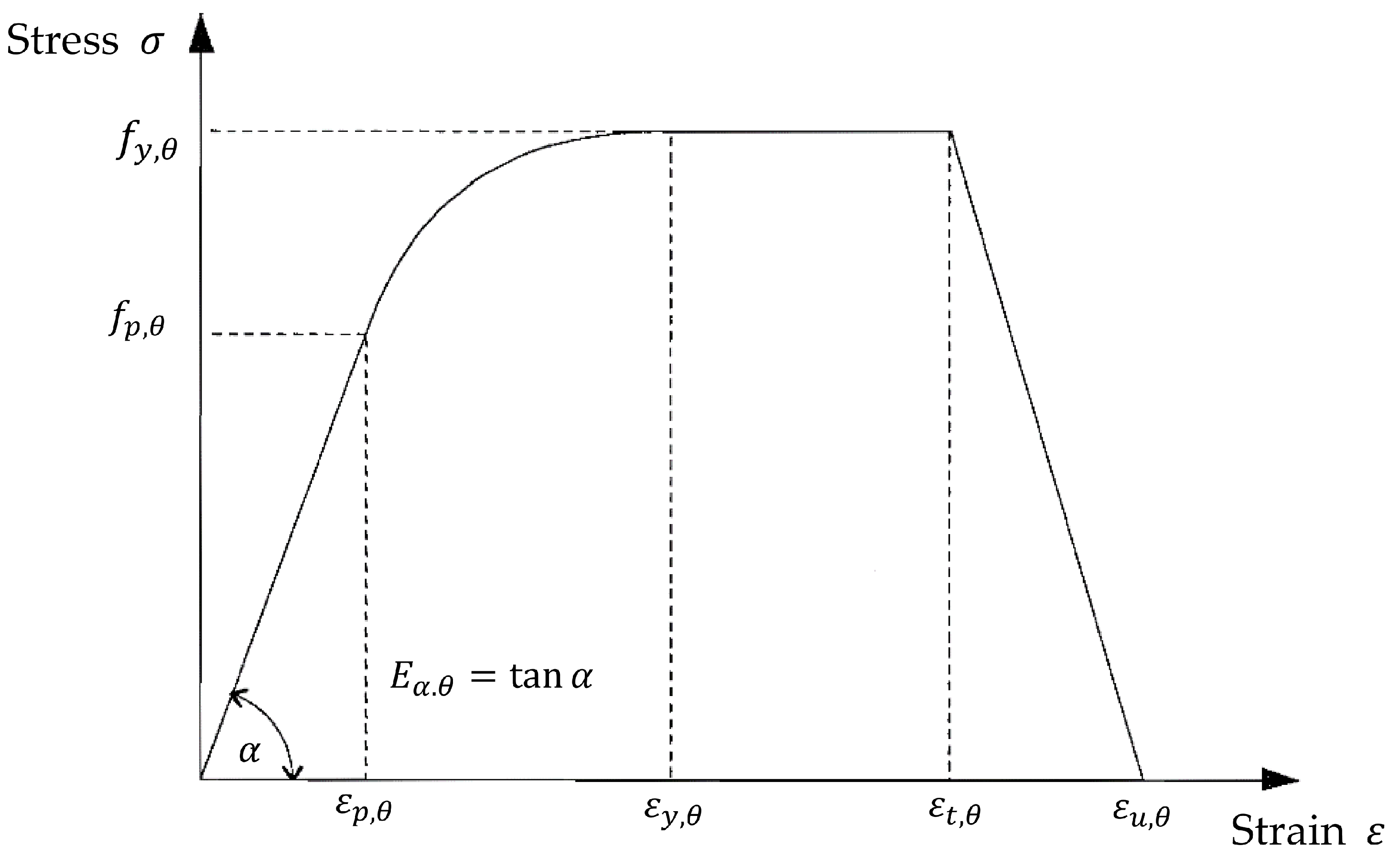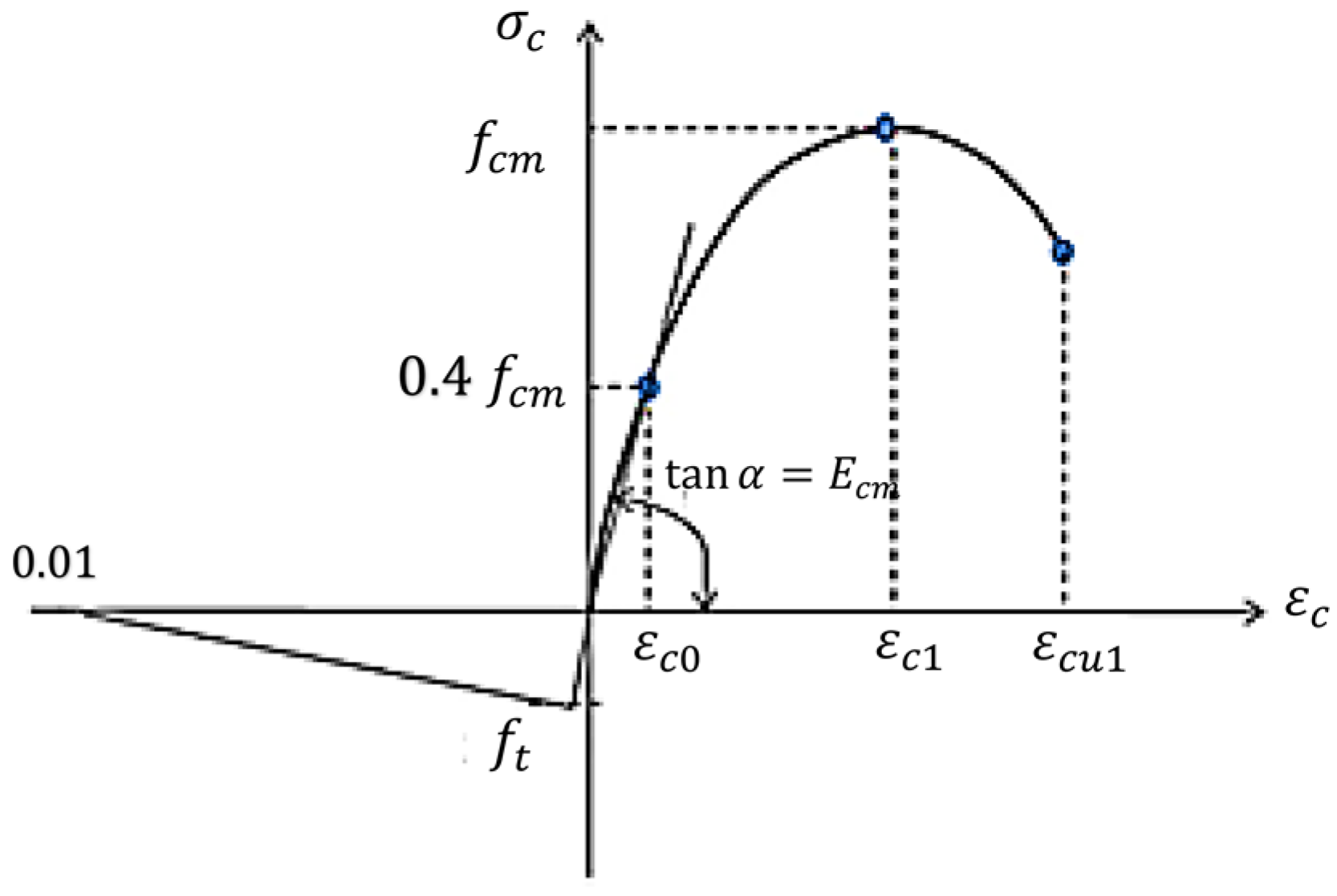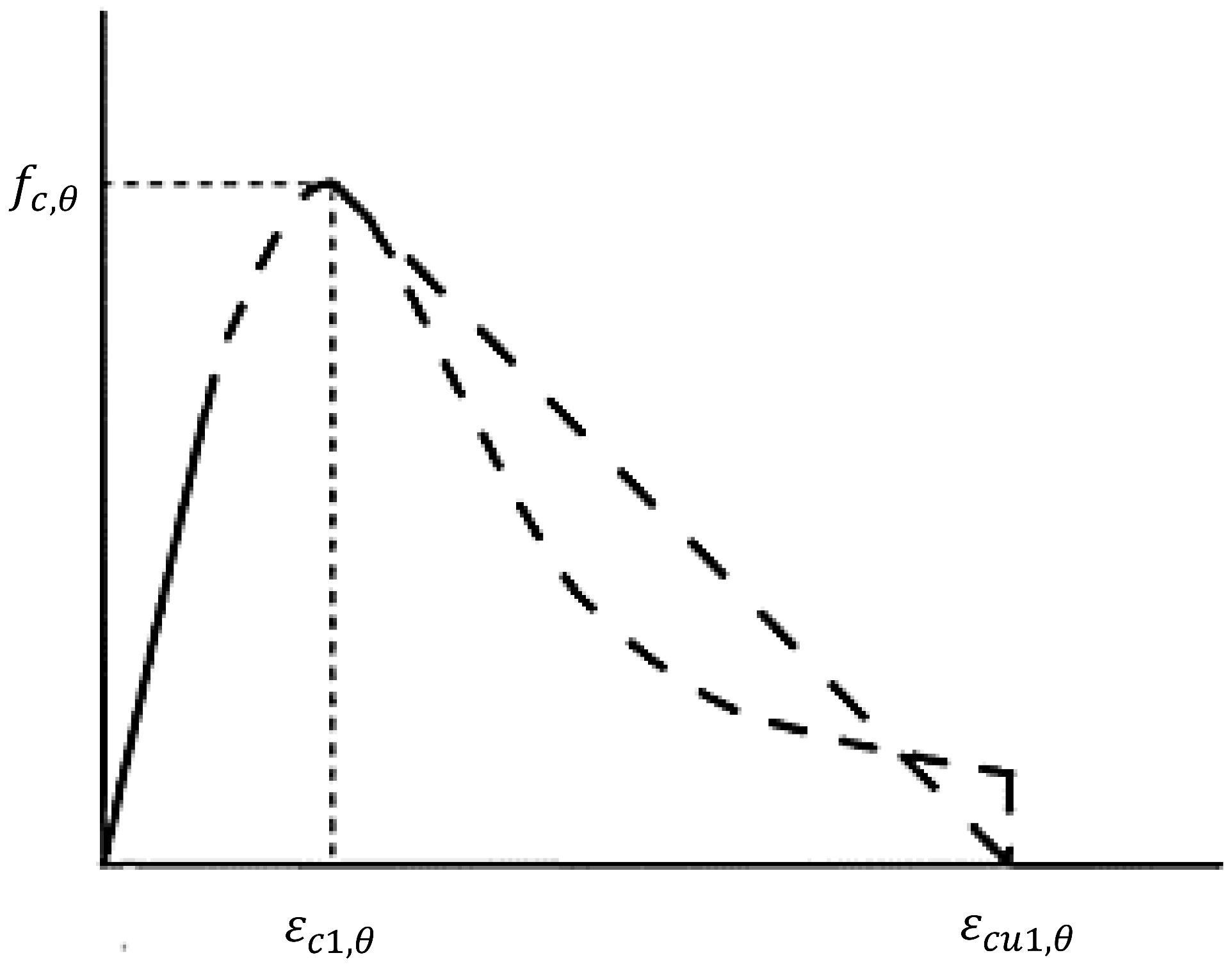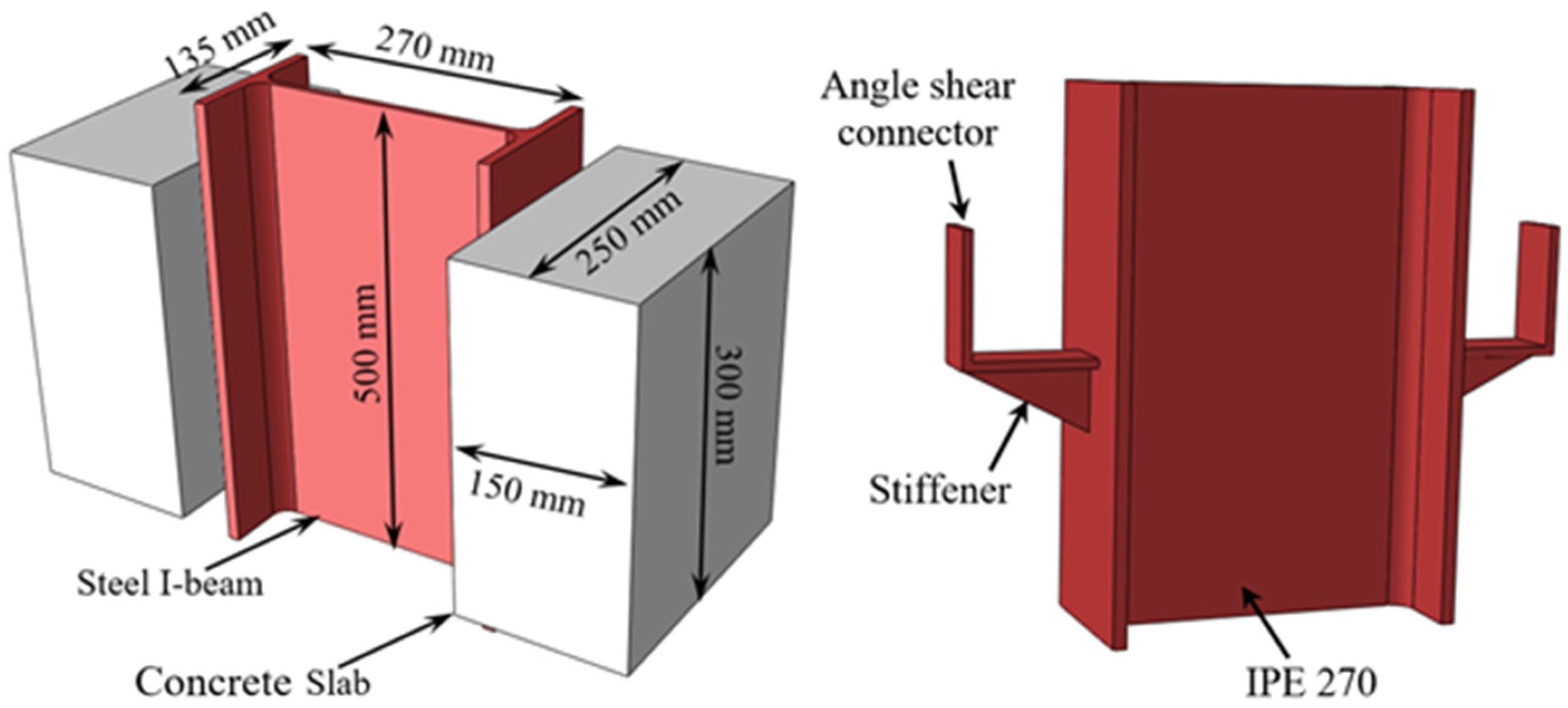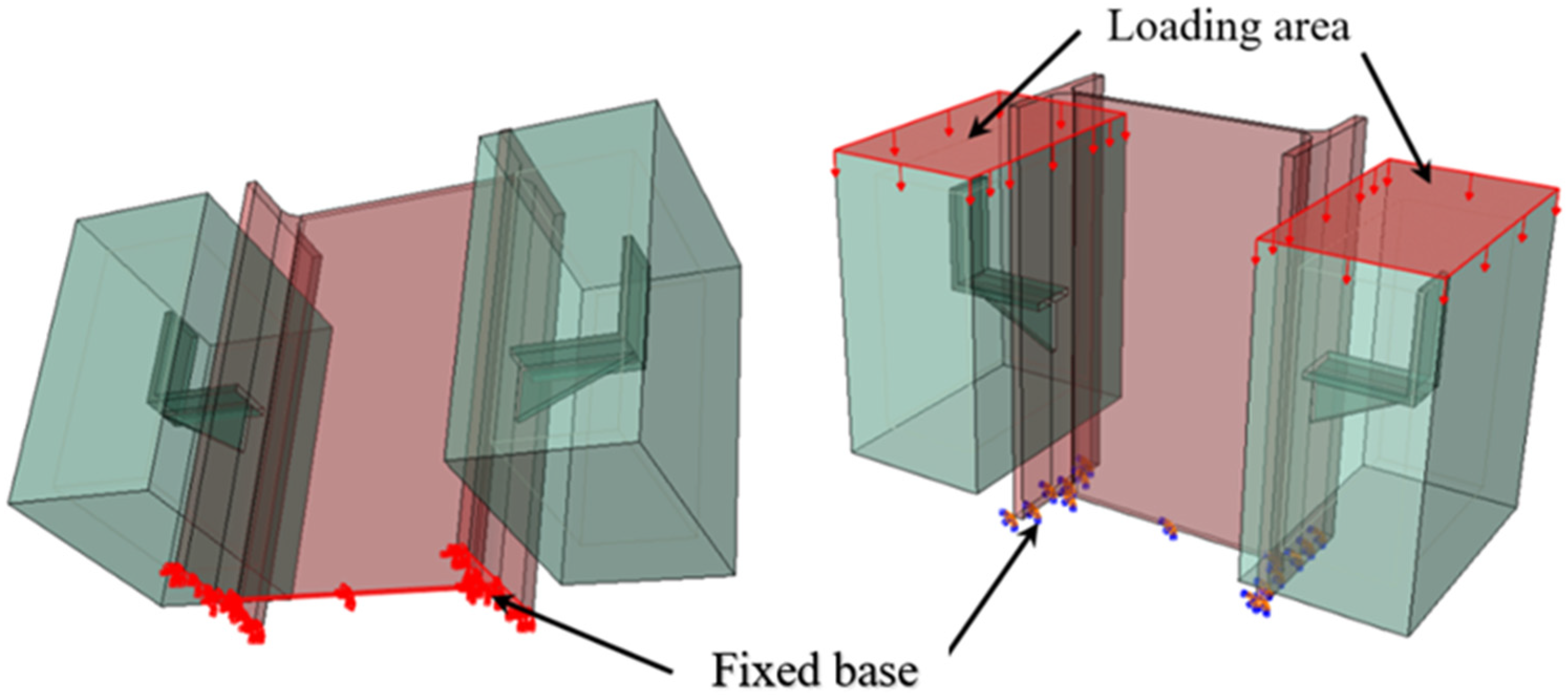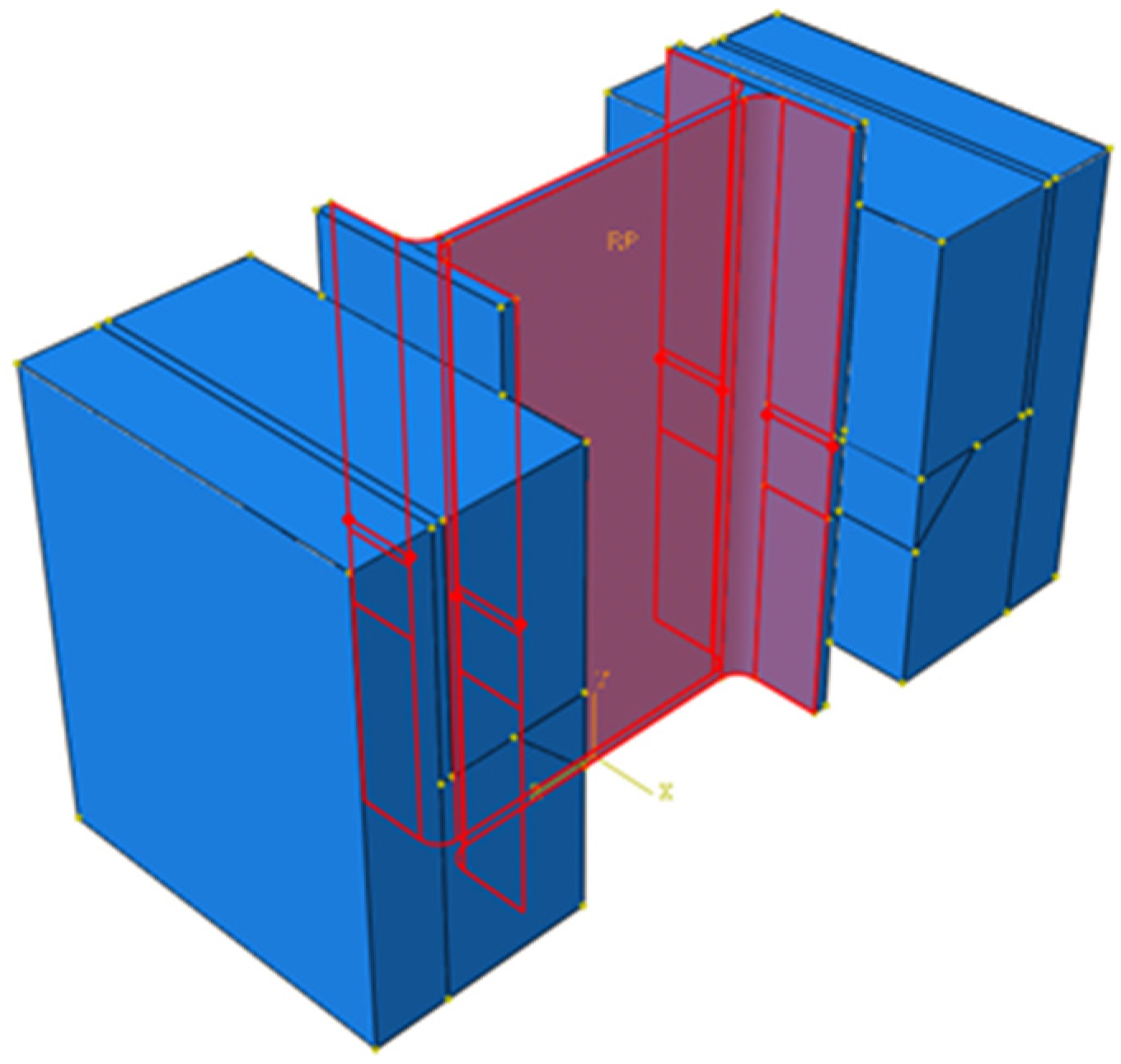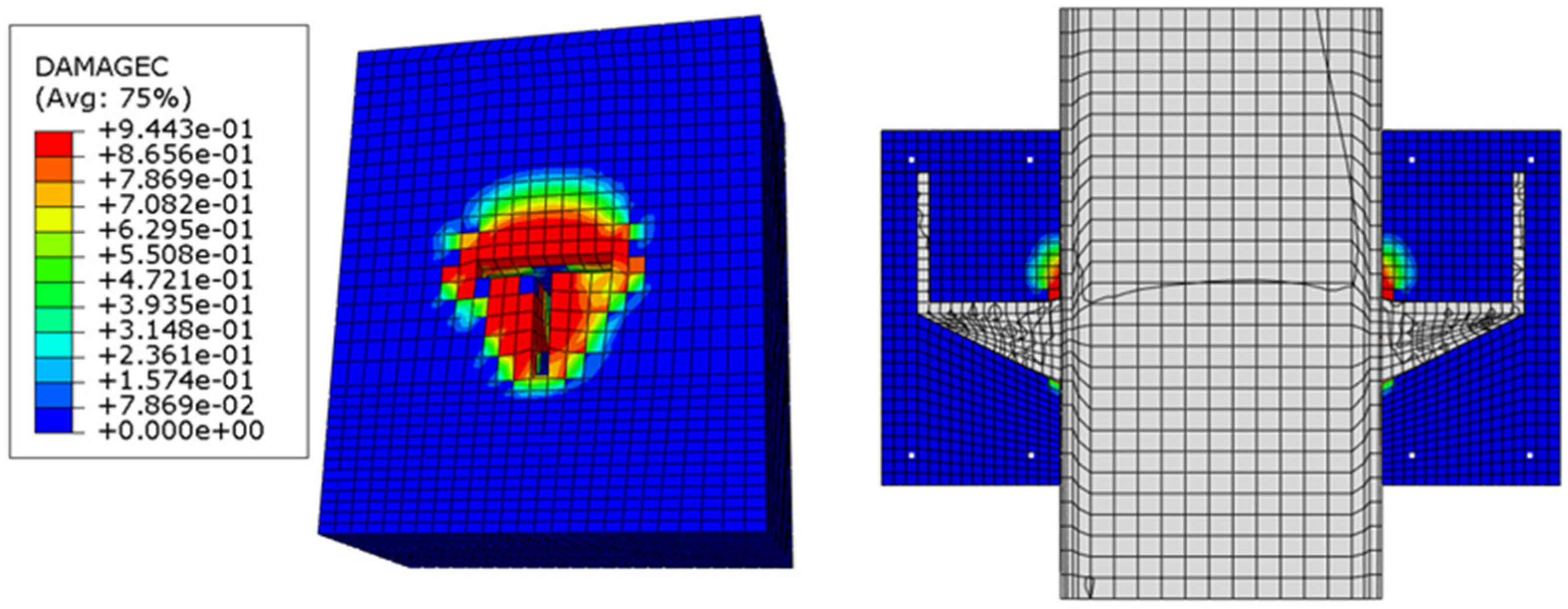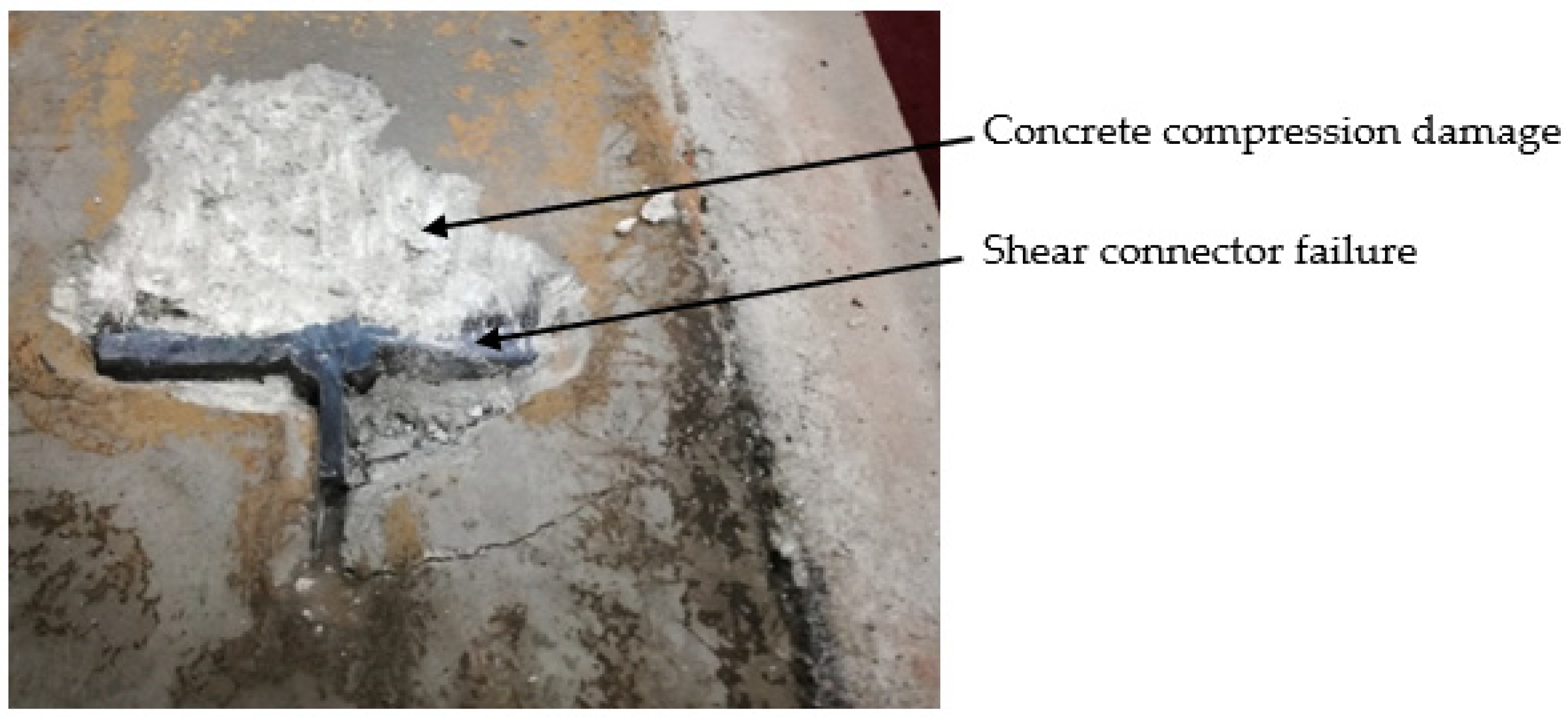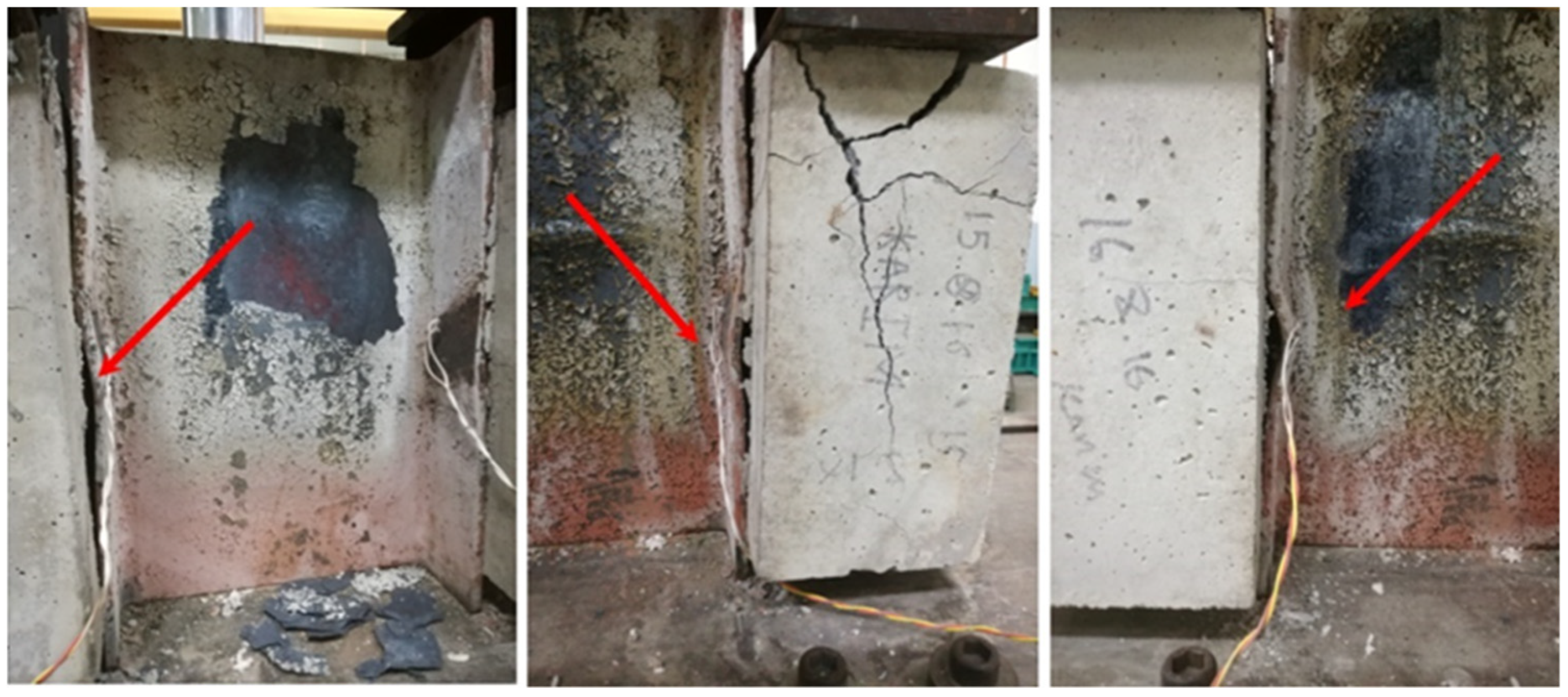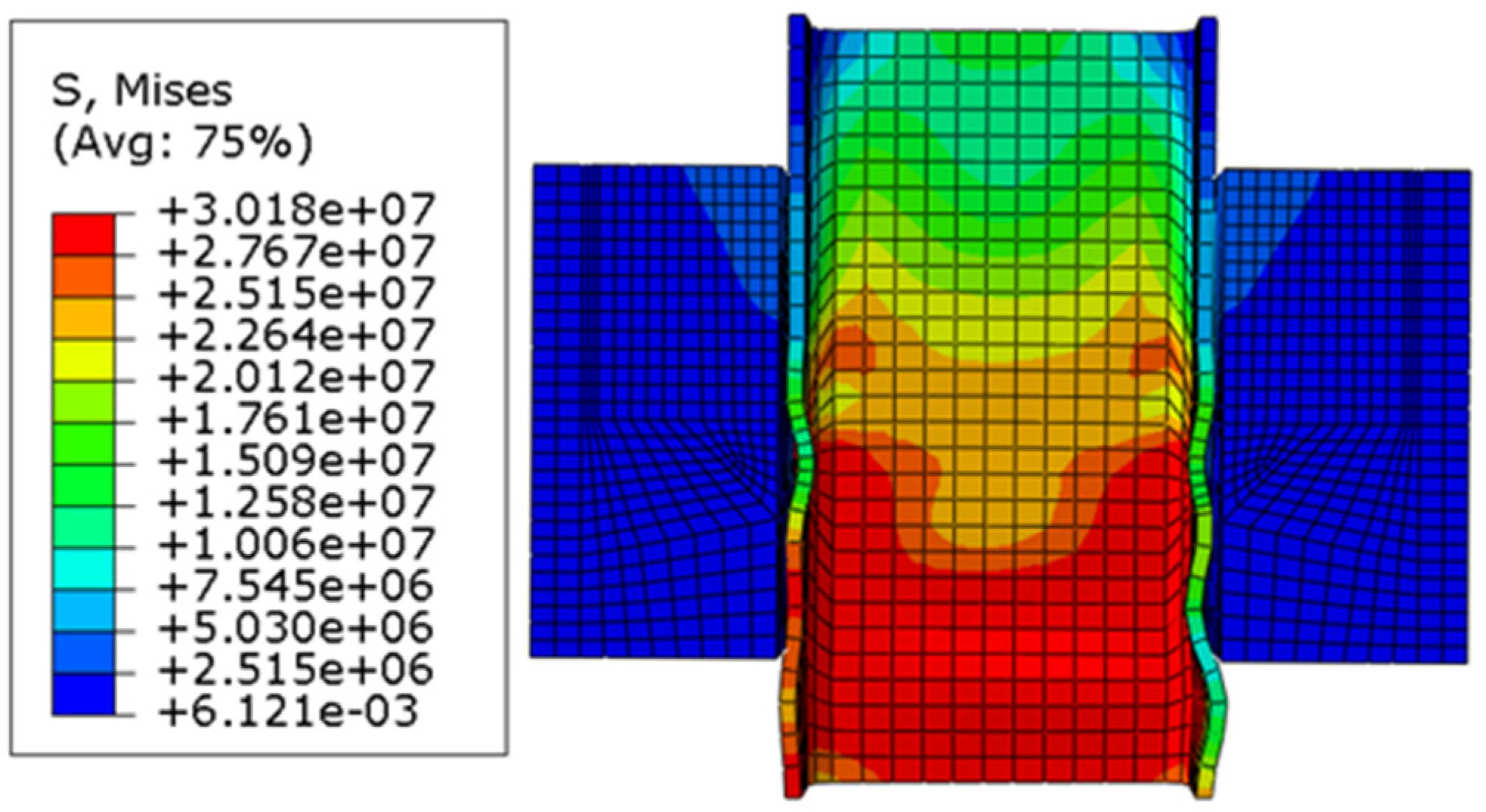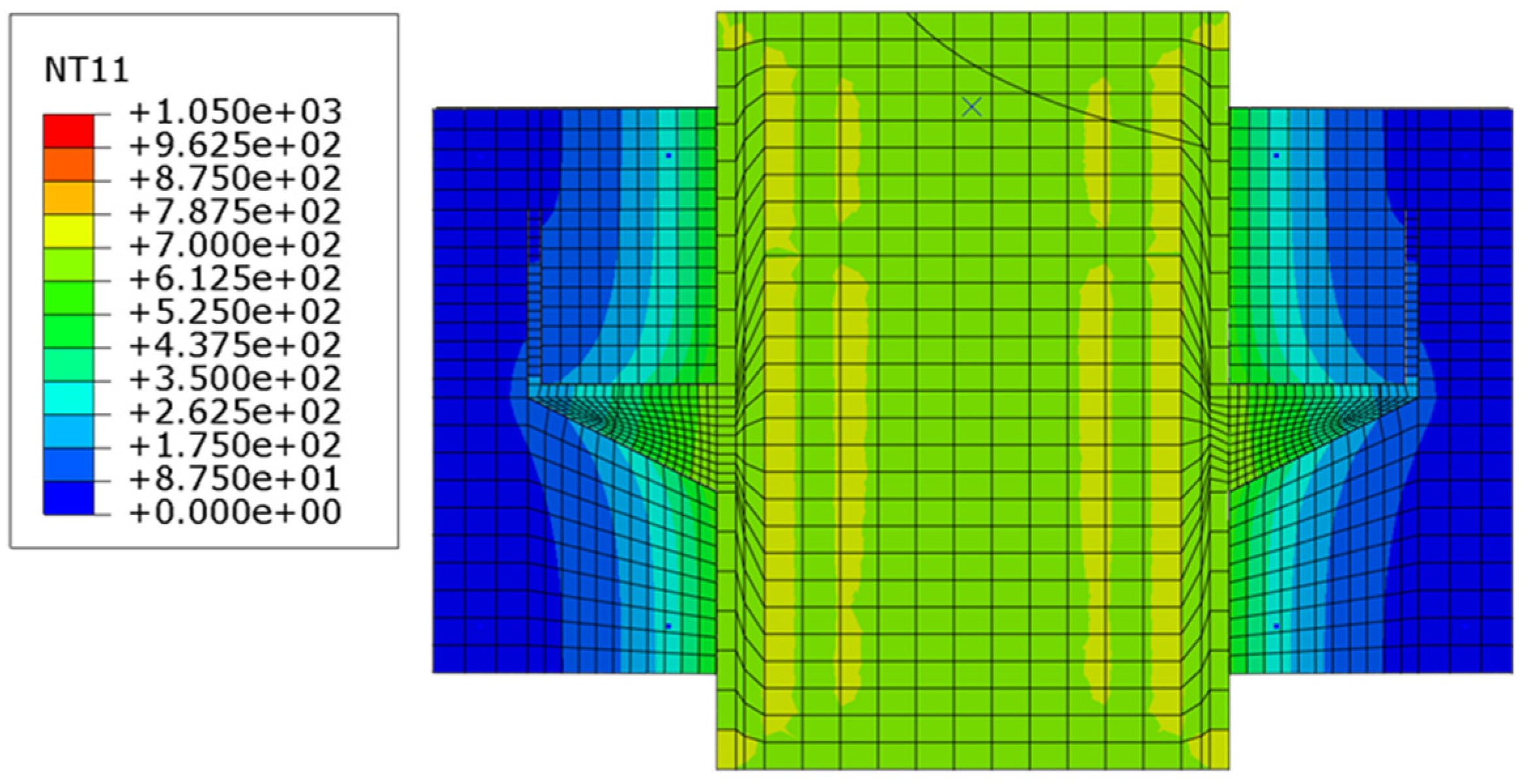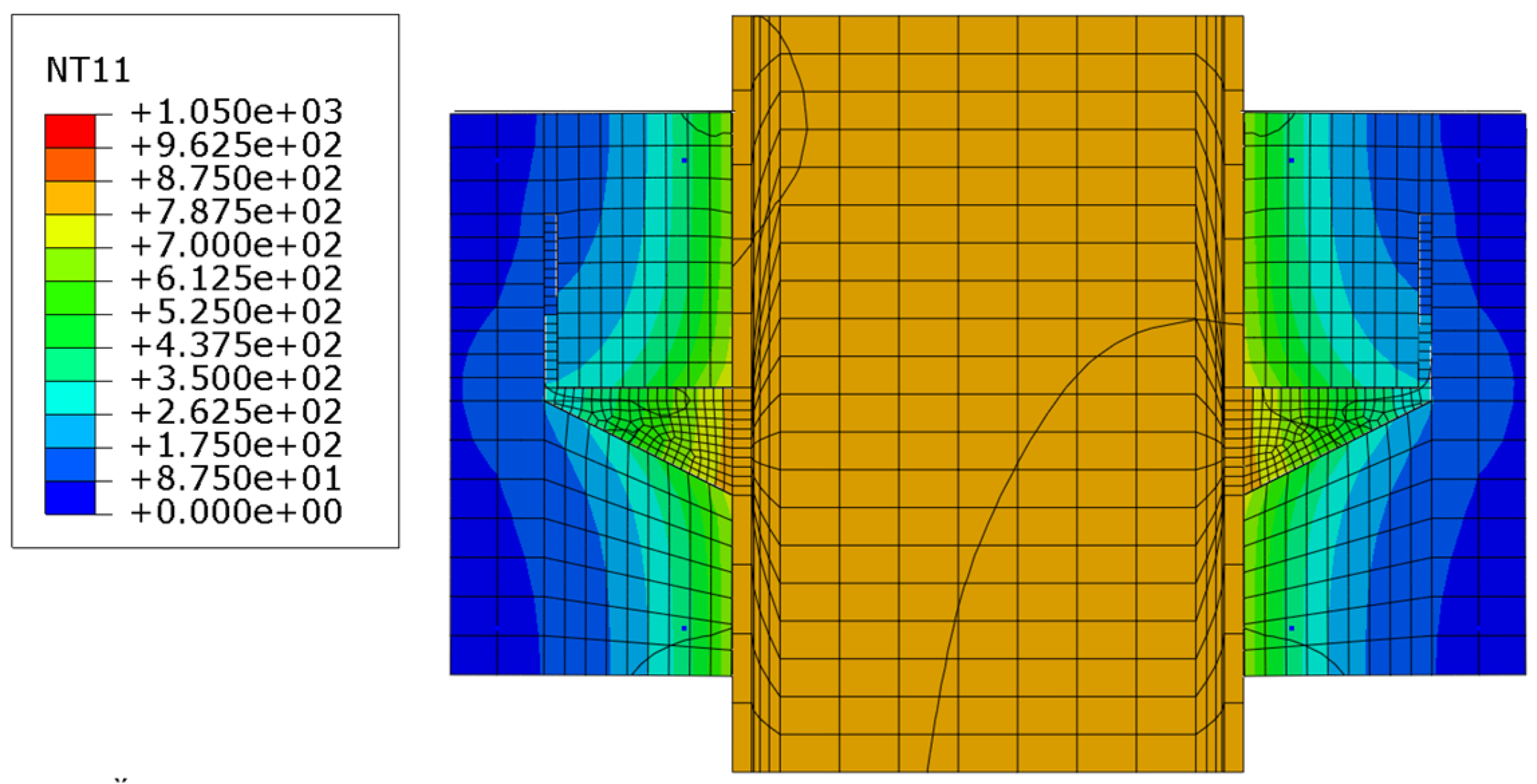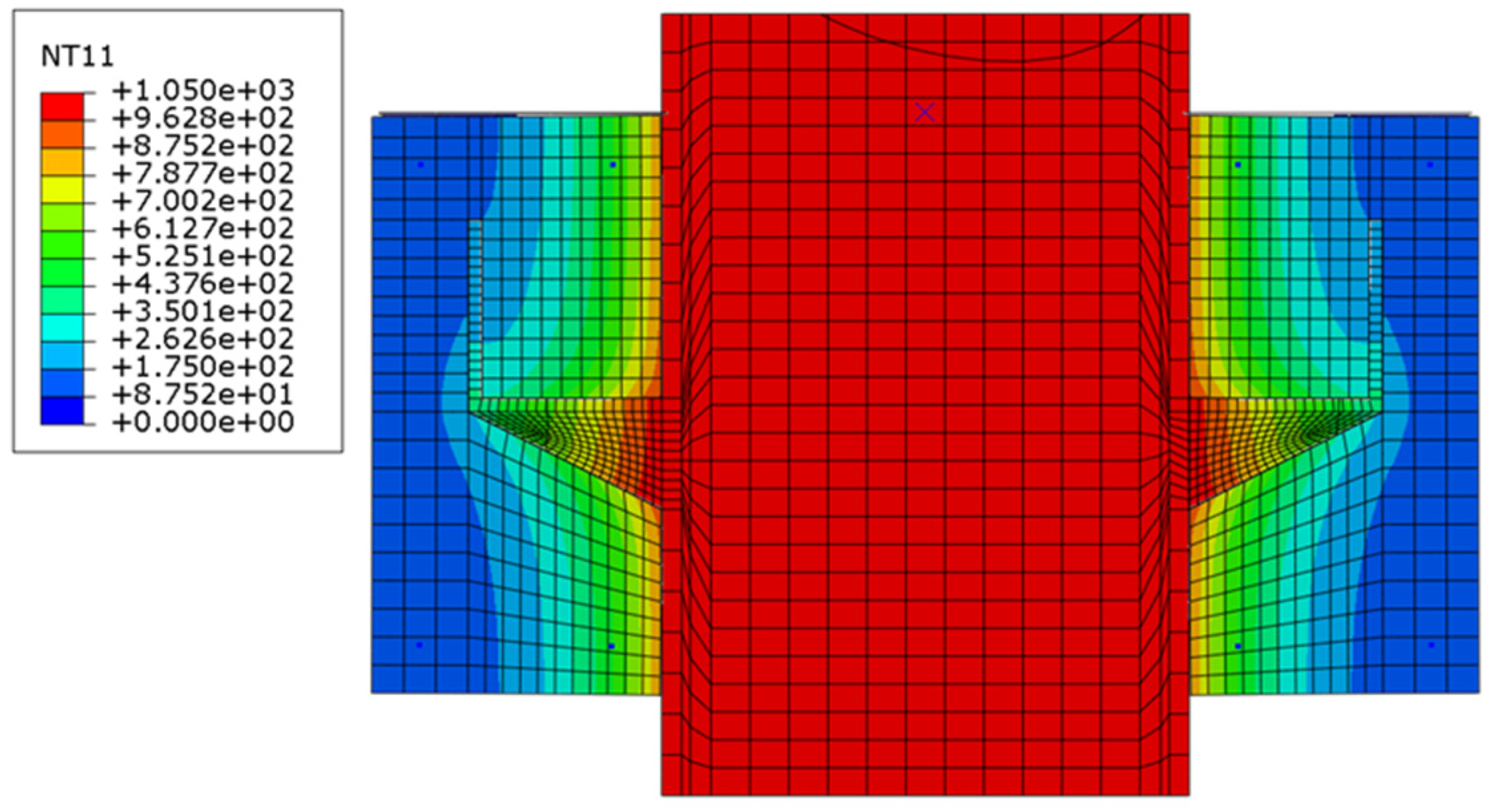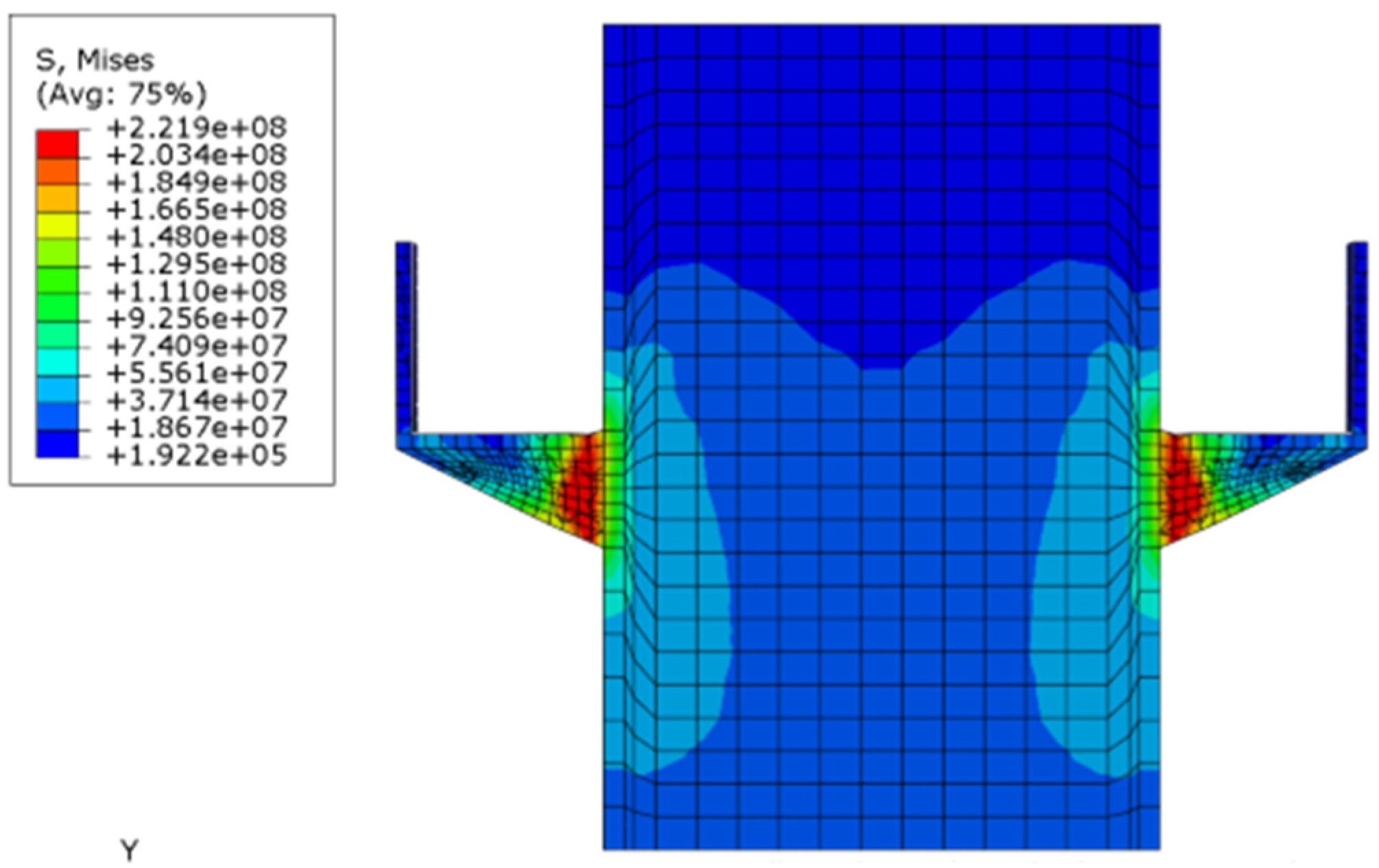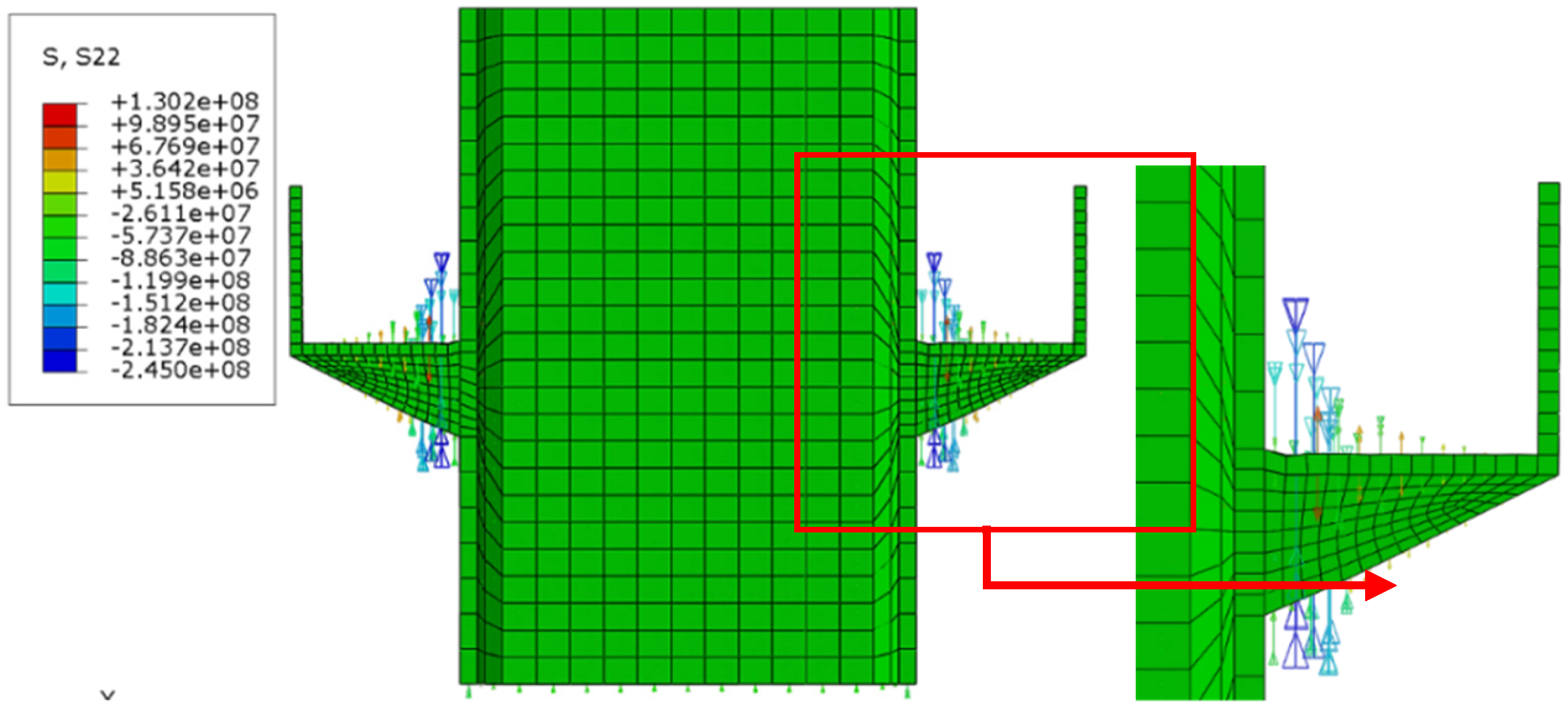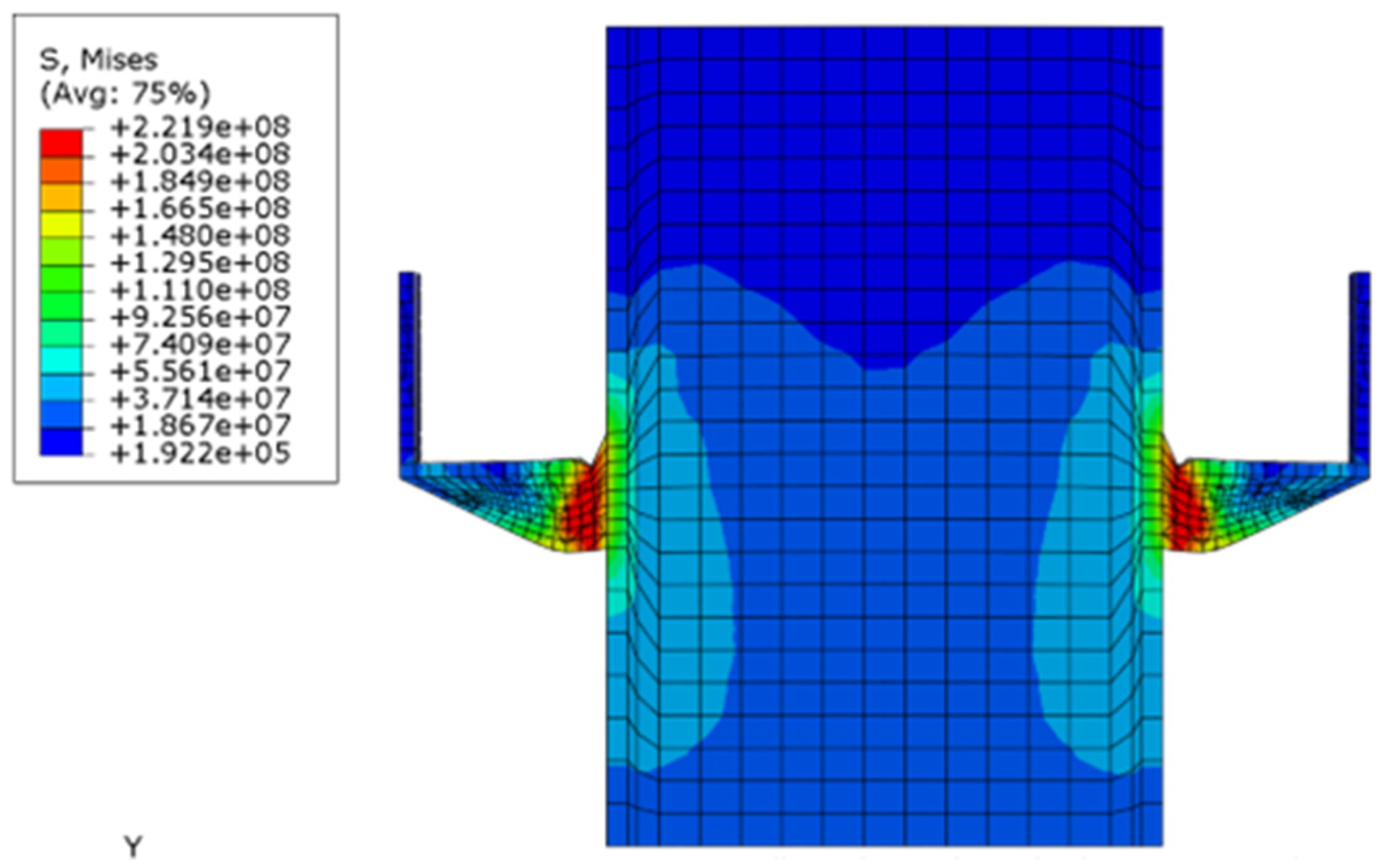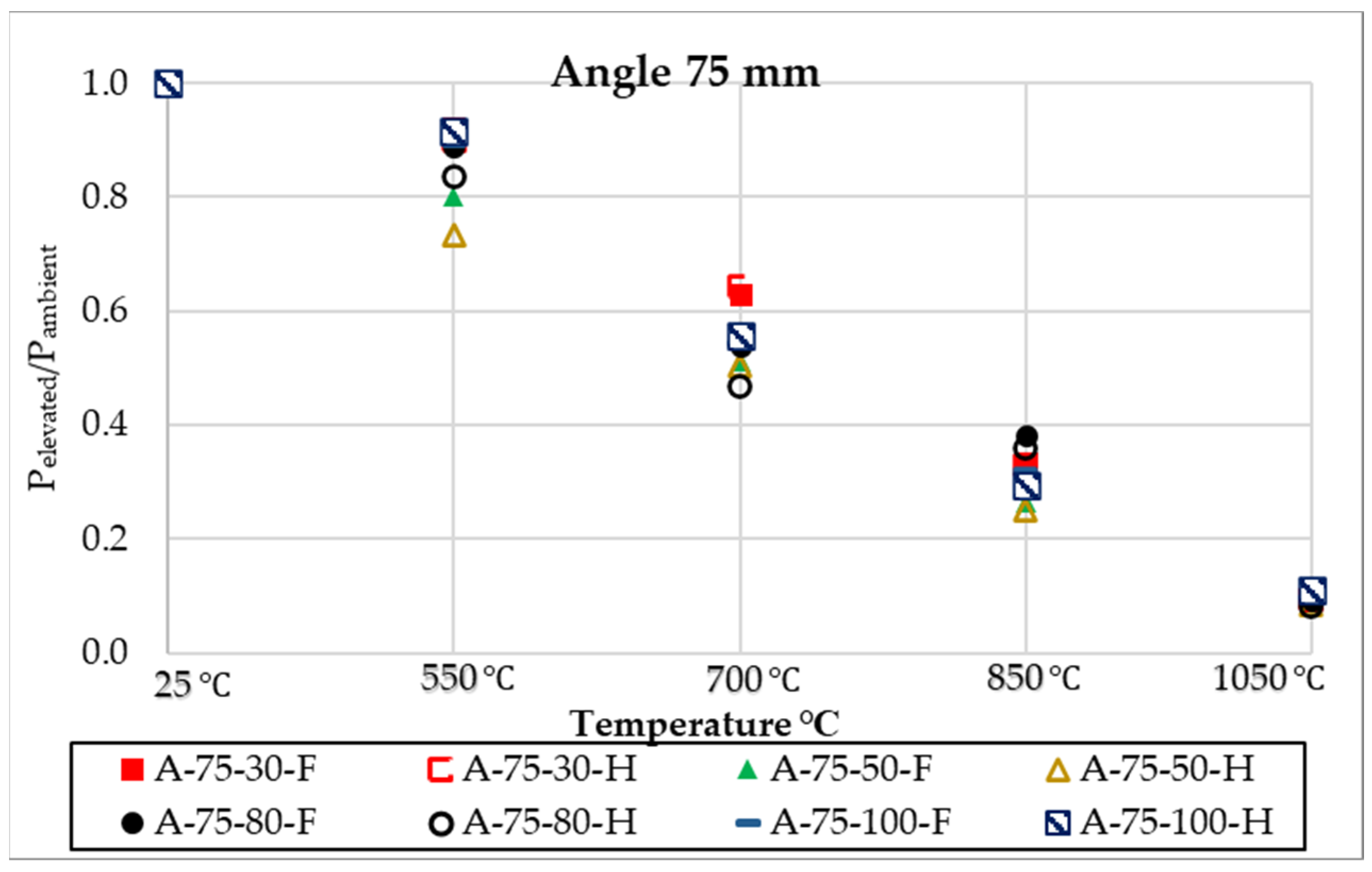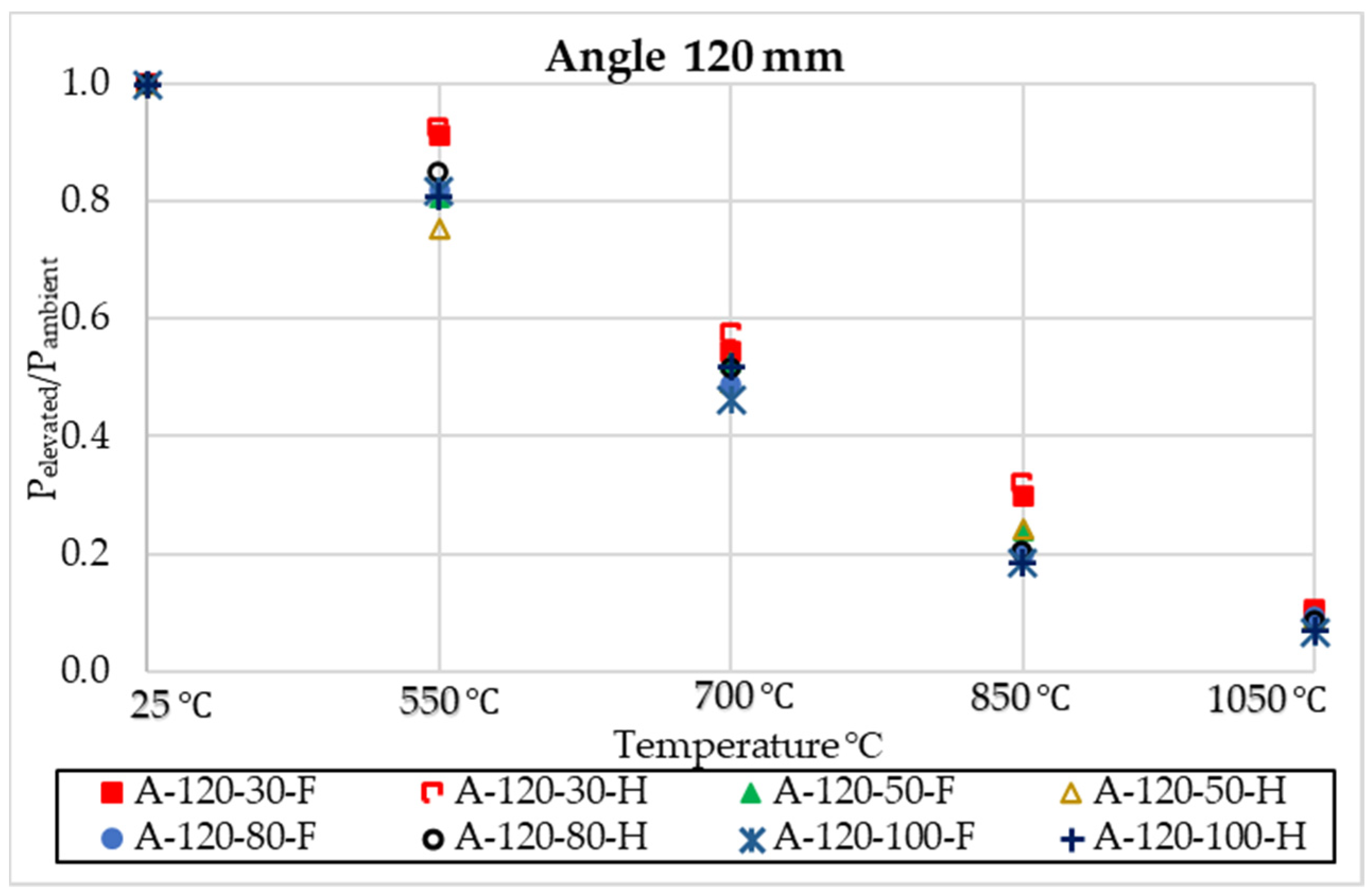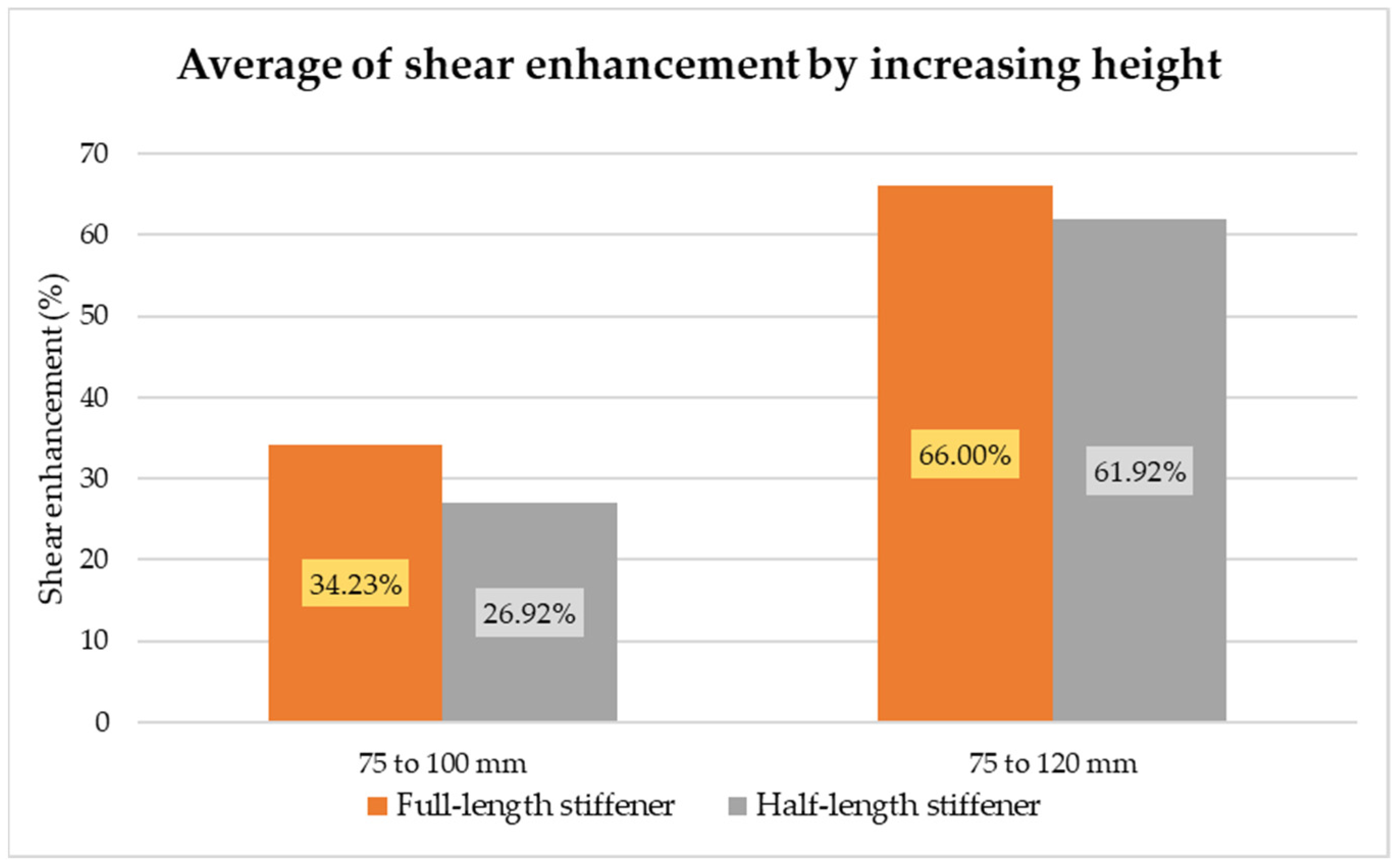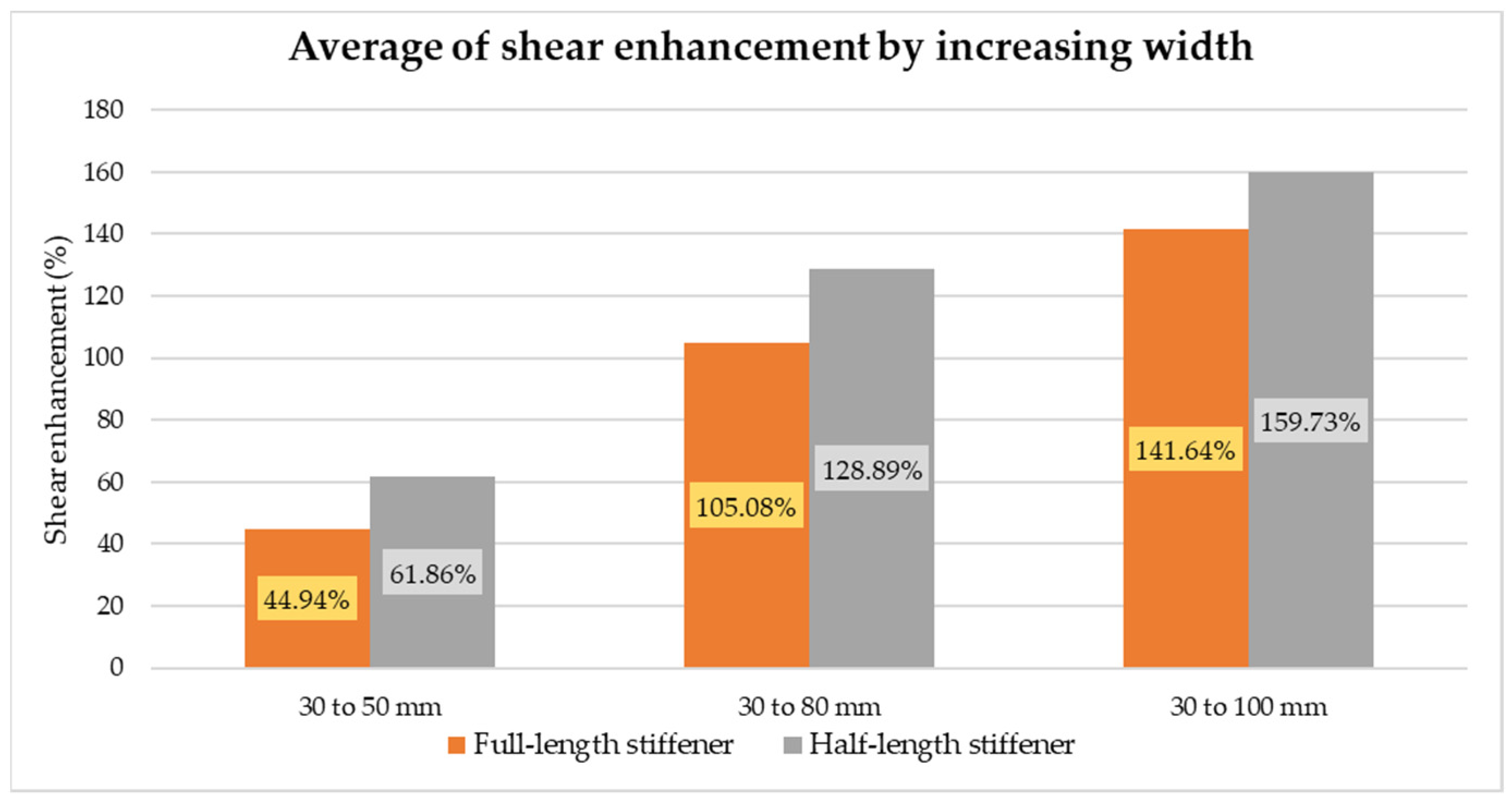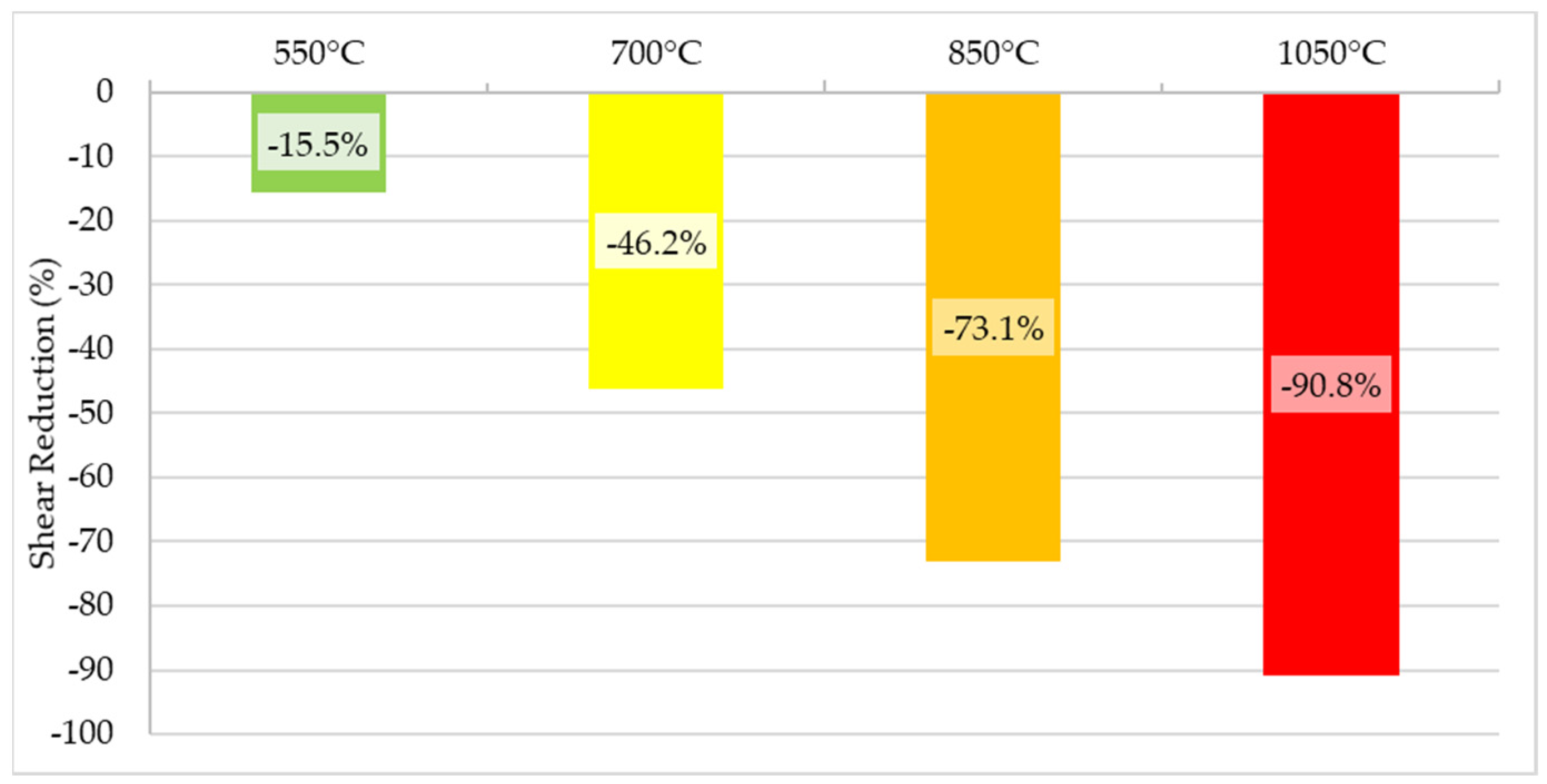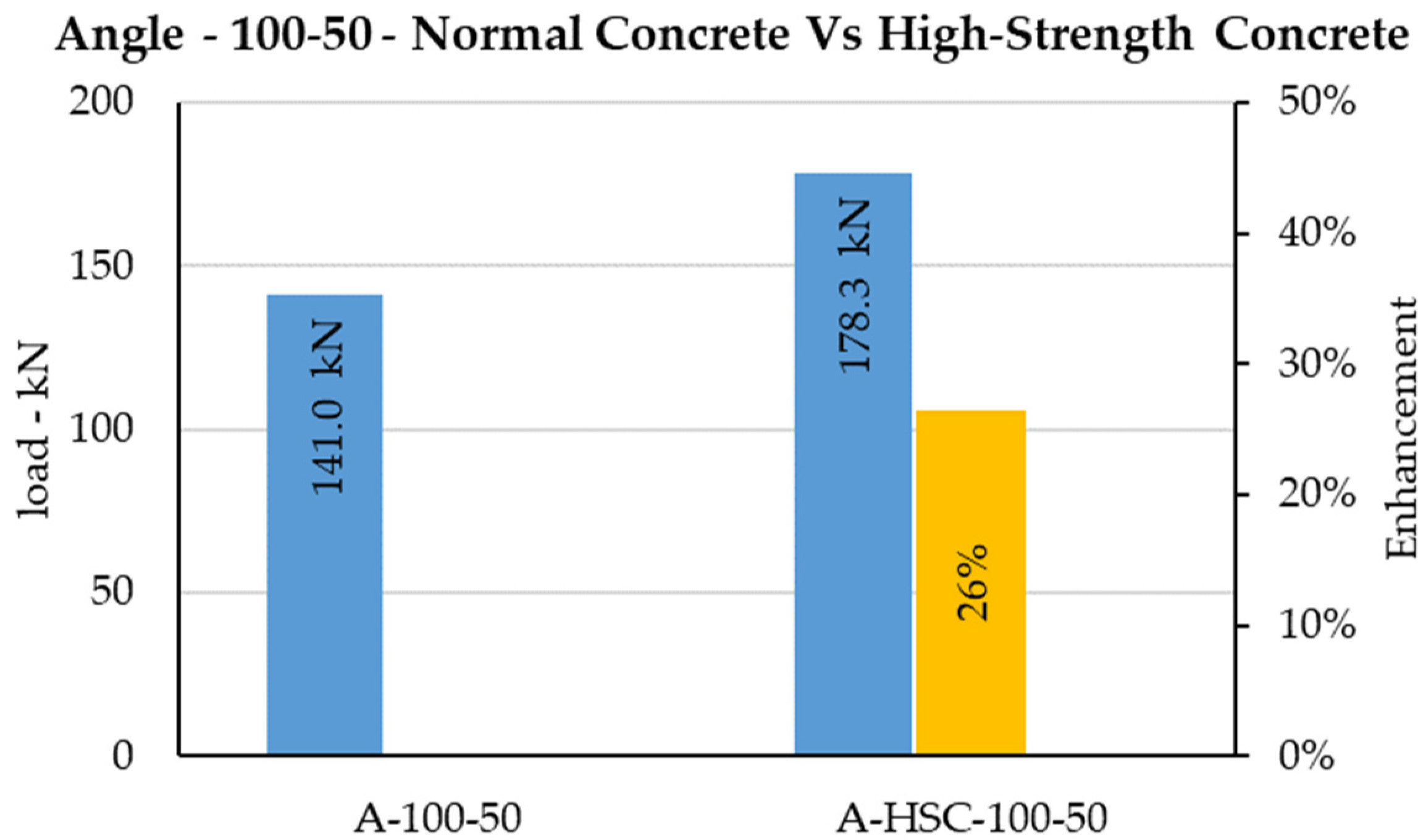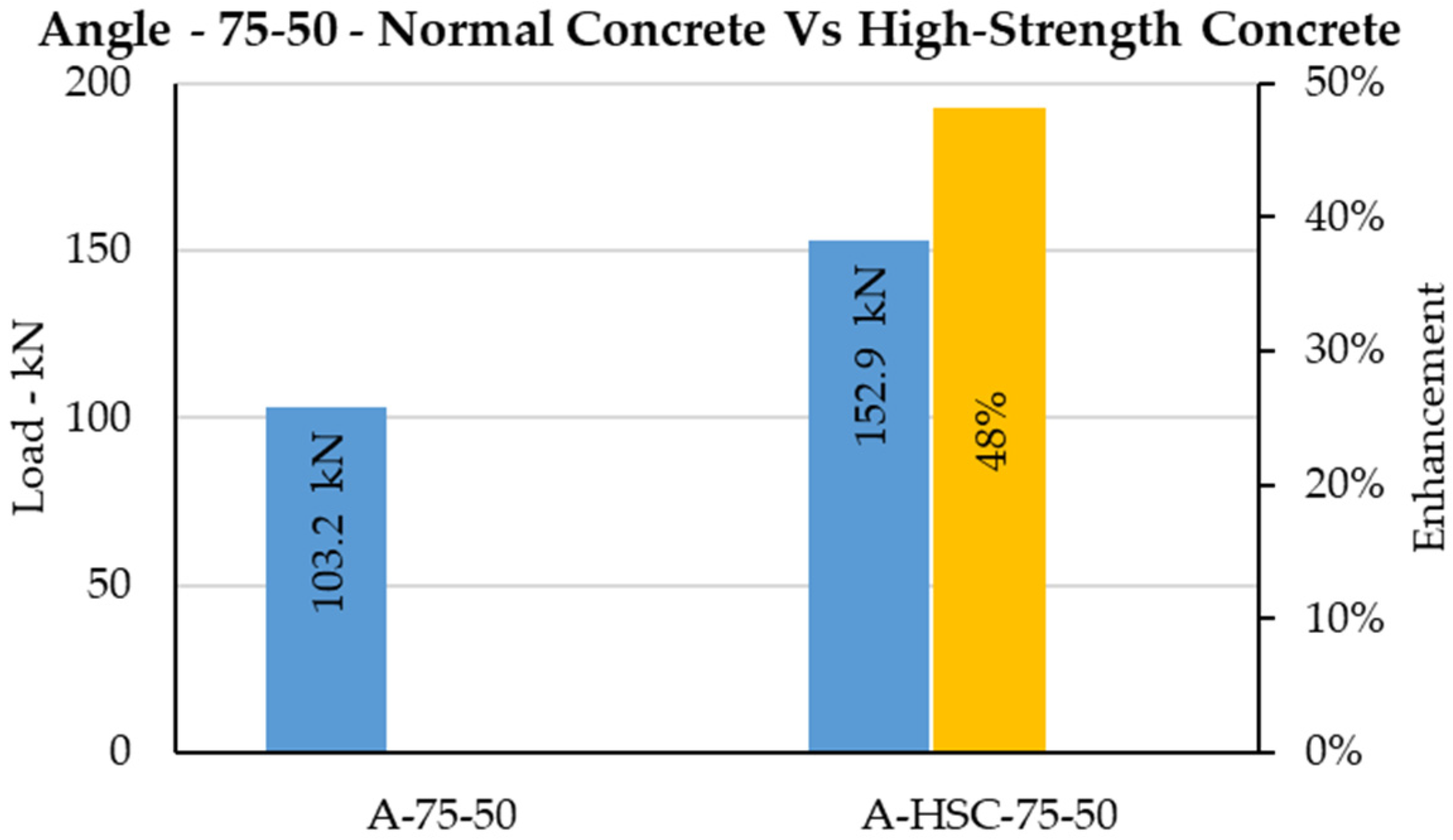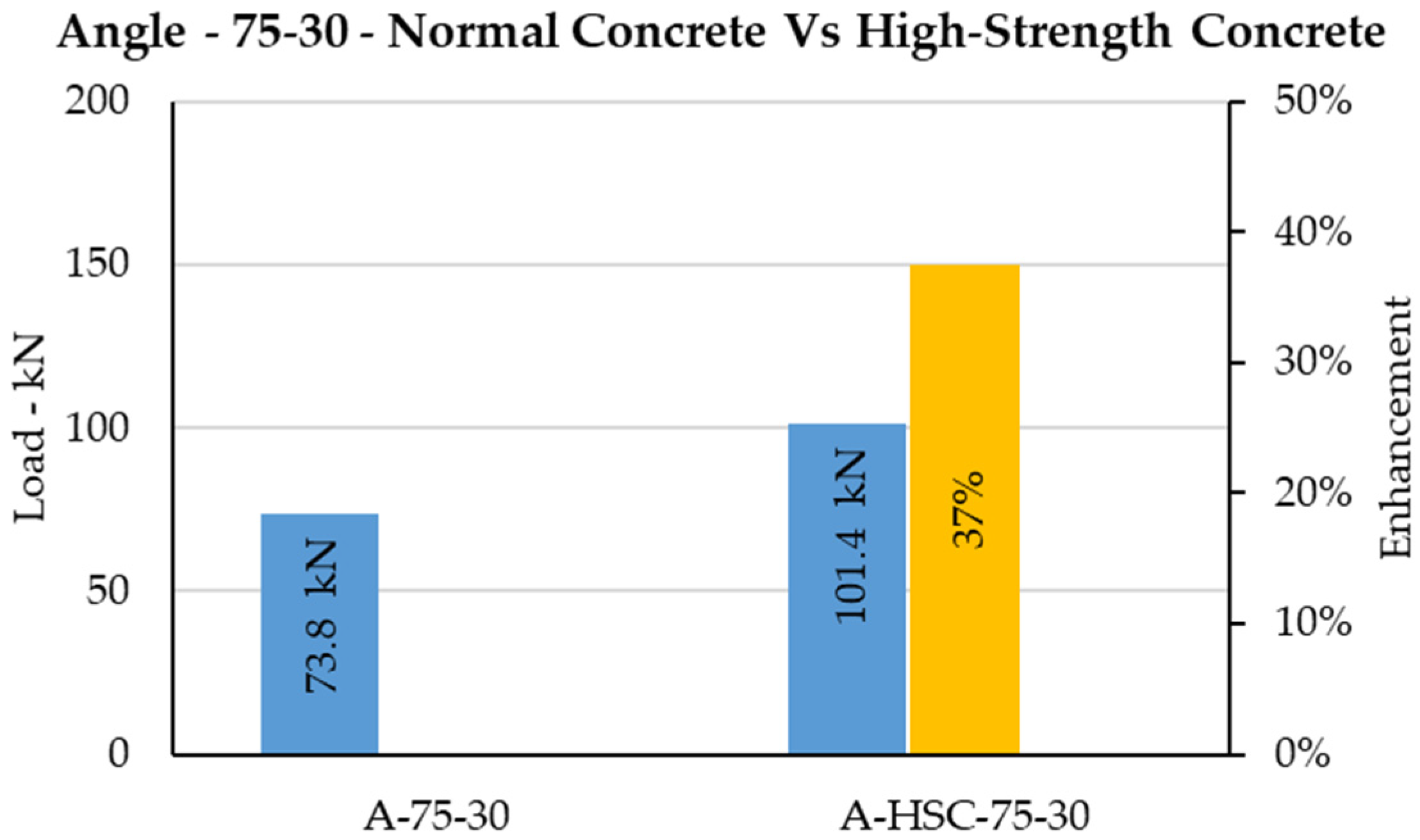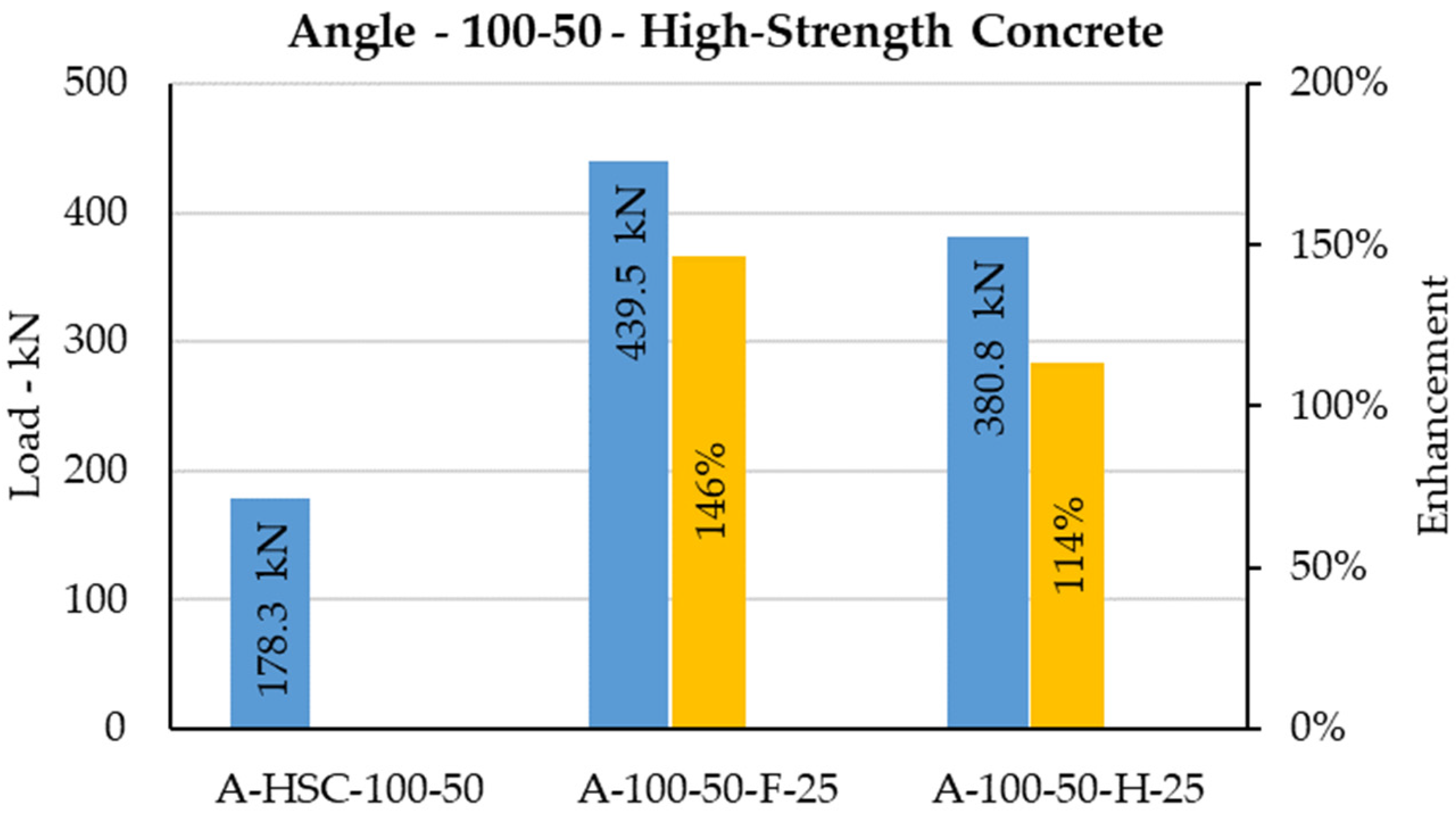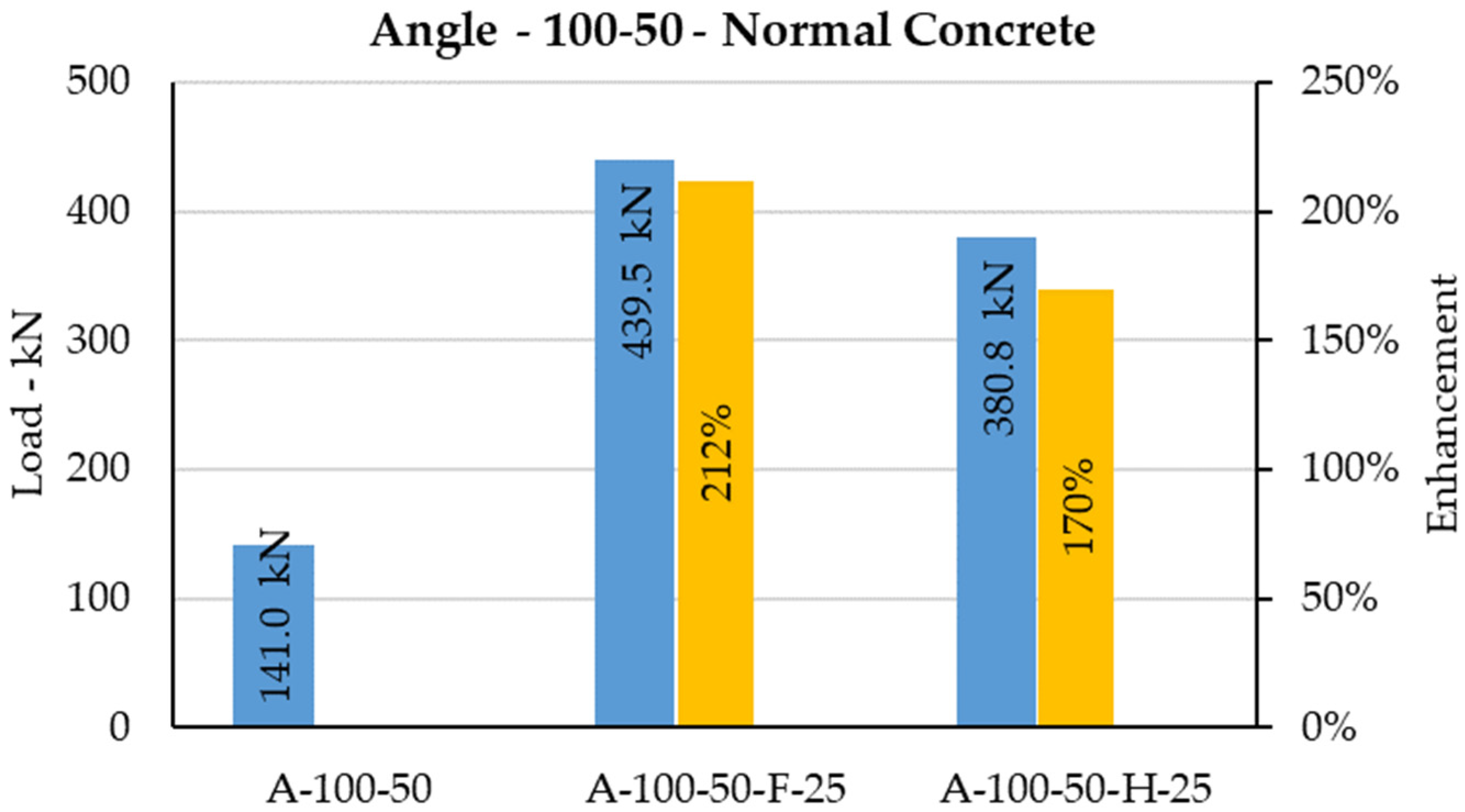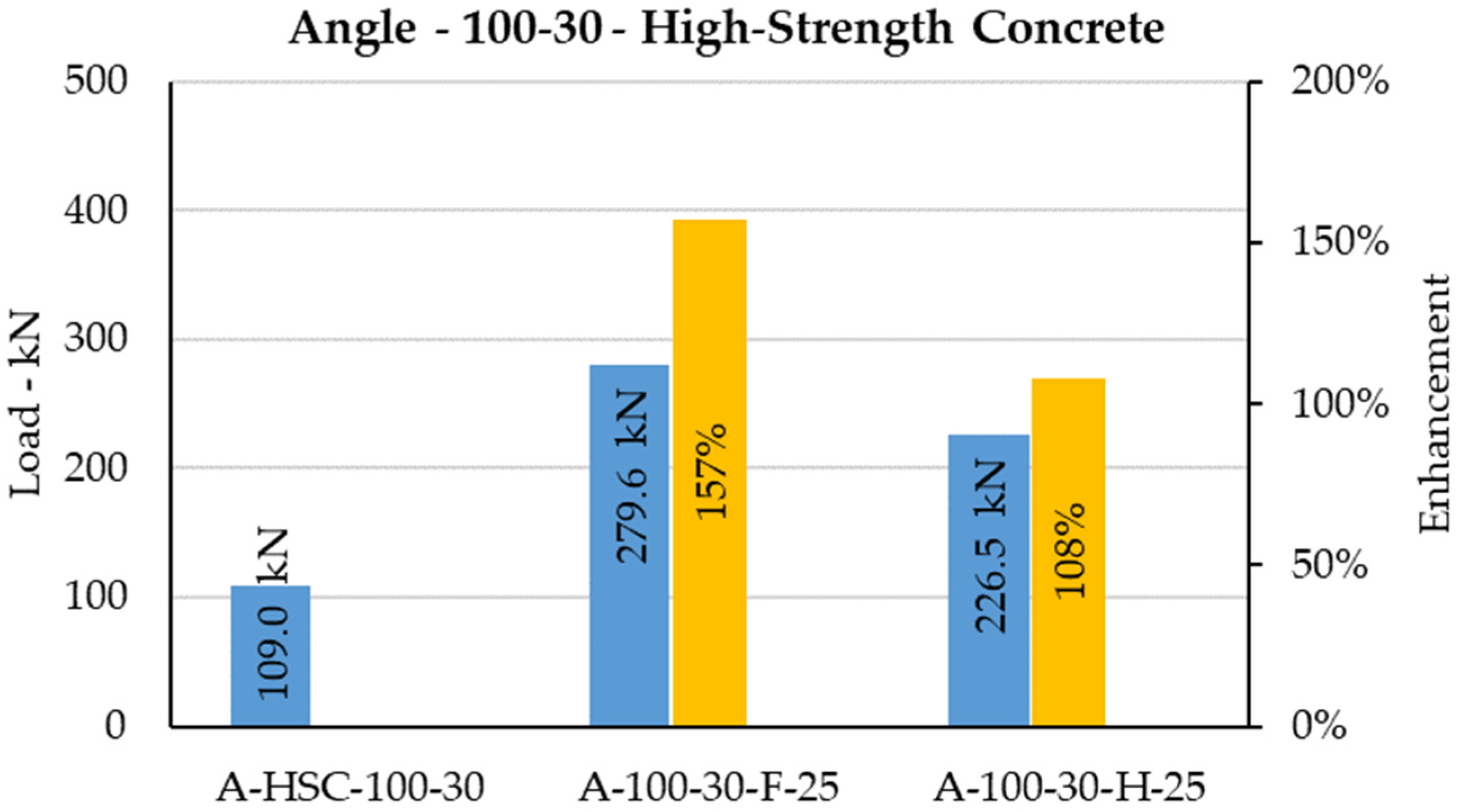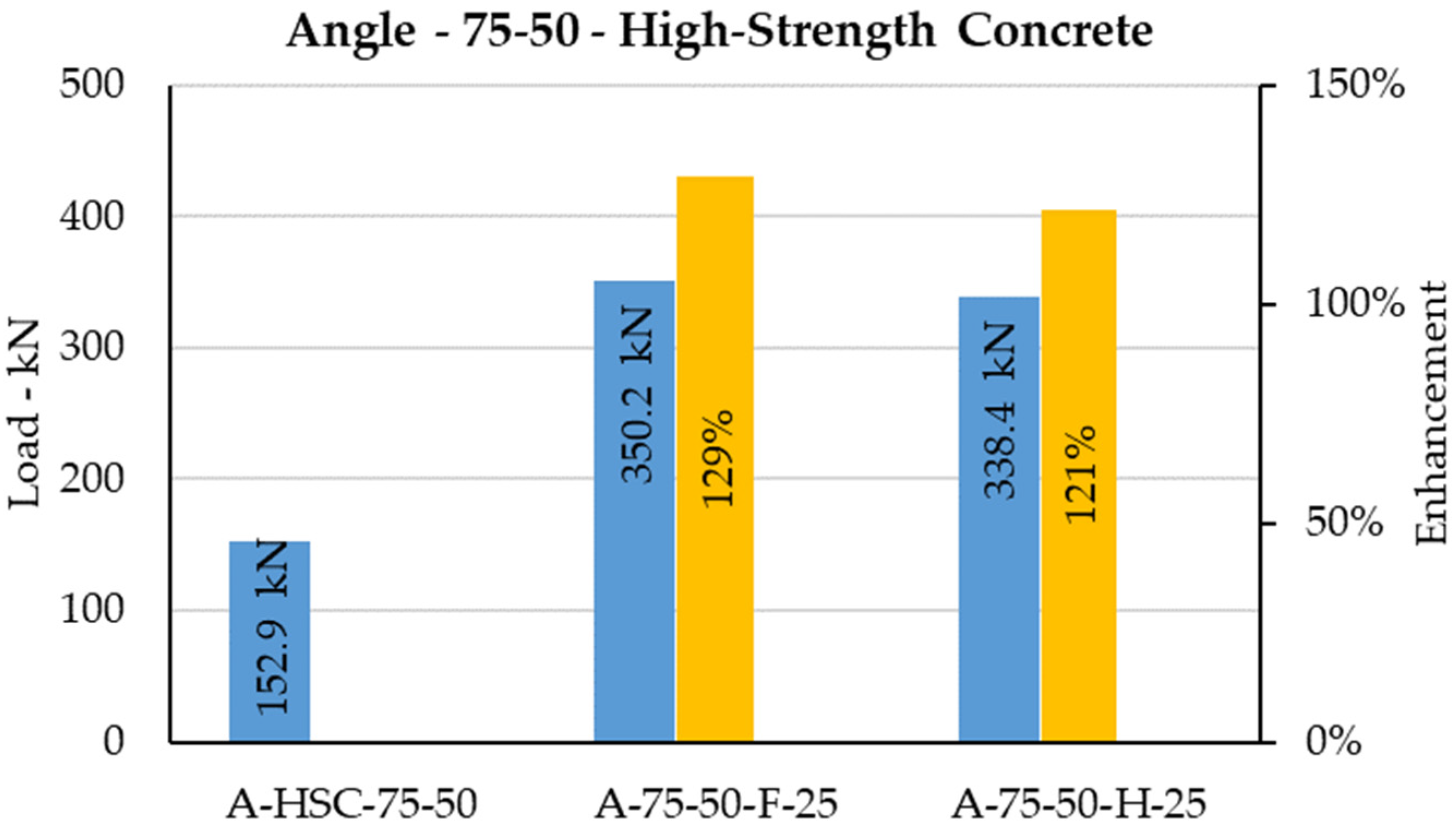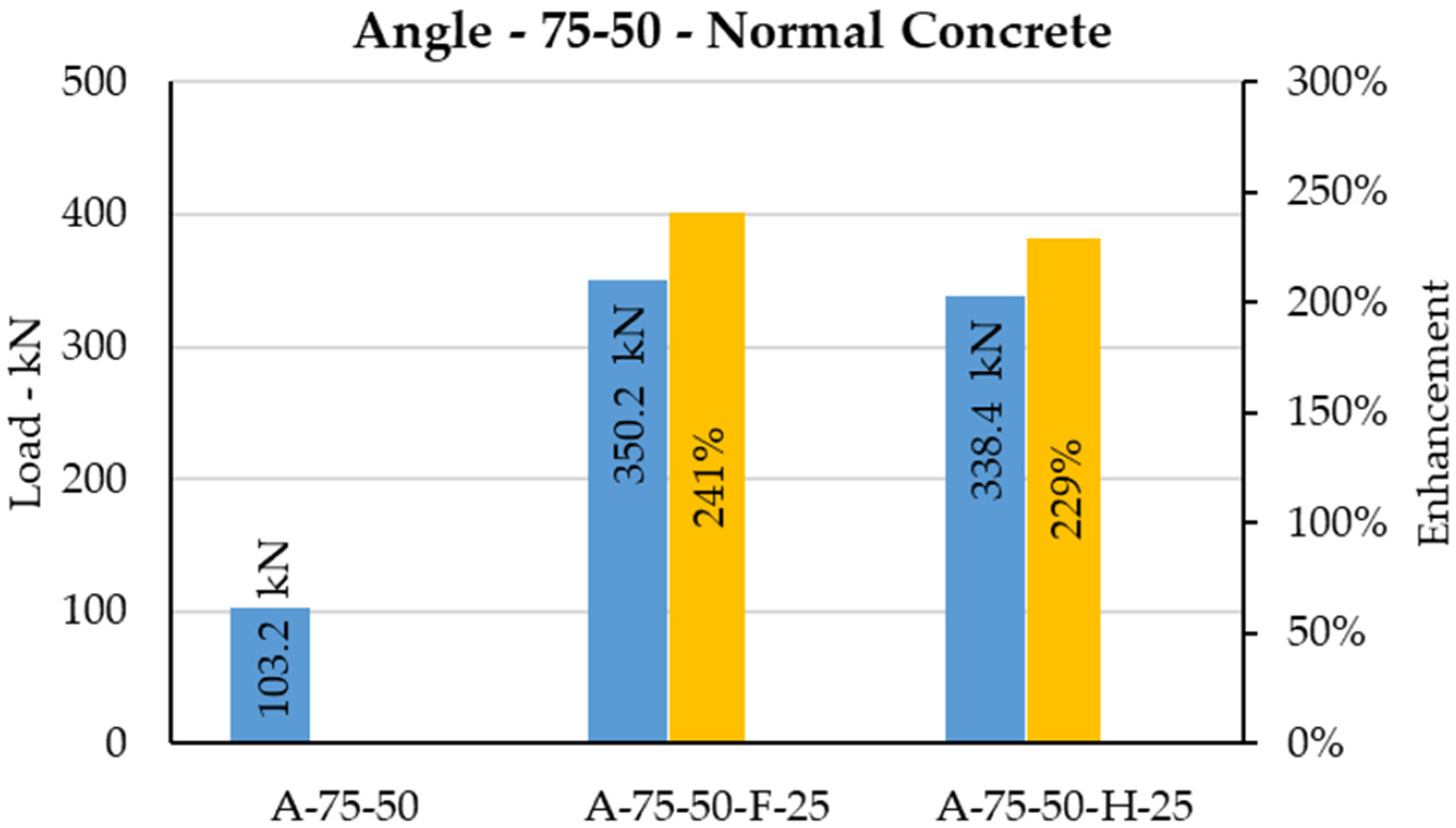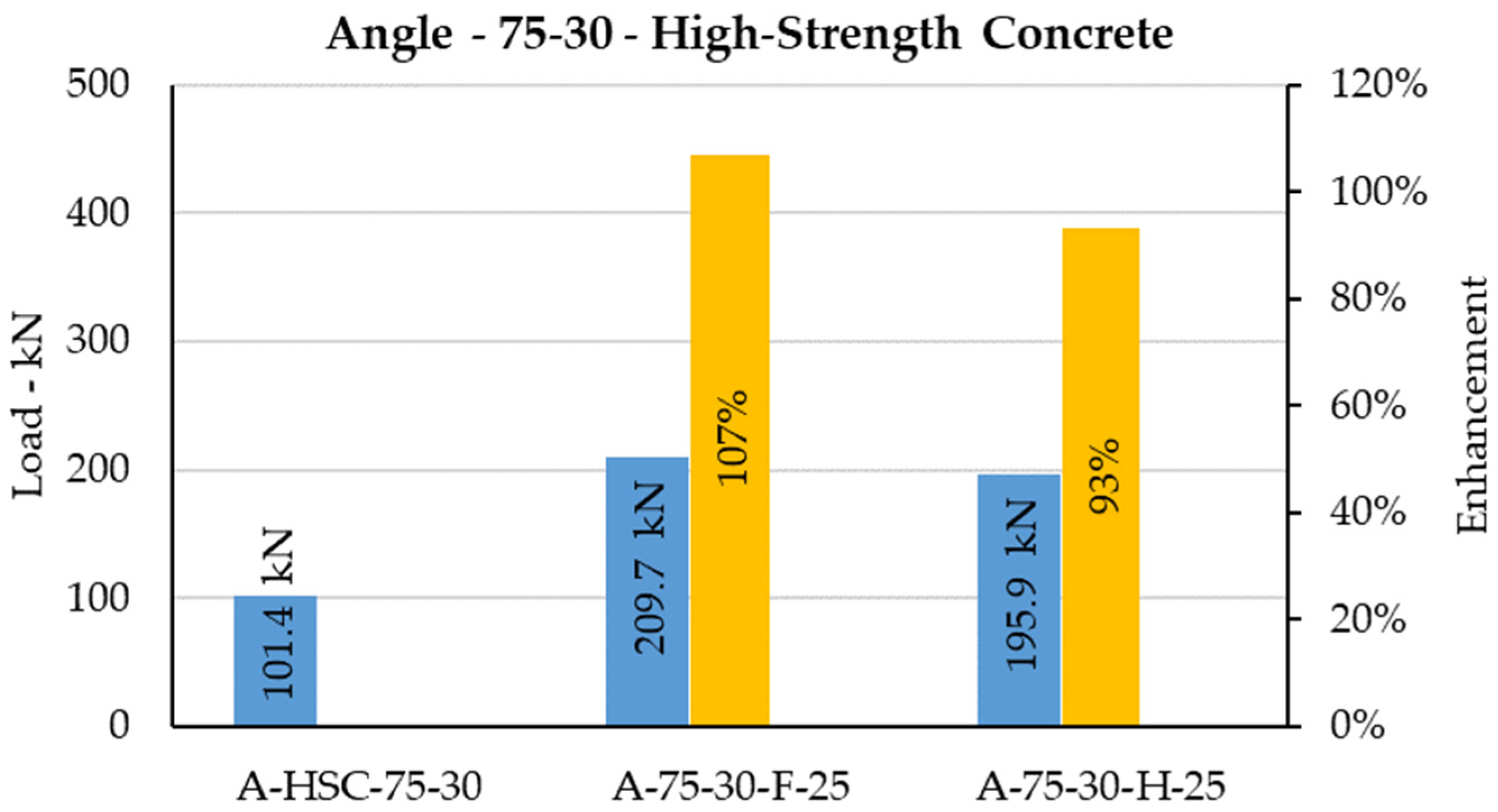1. Introduction
The shear connector between concrete slabs and steel beams is one of the major components in composite constructions and can play a vital role in the behavior of structures. Headed stud and Perfobond shear connectors are the most common types of shear connectors whilst the application of C-shaped shear connectors has increased over the last decades. The shear connectors help to send the significant horizontal inertial forces in the slab to the major lateral load resisting parts of the structure, which provide the necessary shear connection for composite action in flexure. In the case of a fire, a composite structural system behaves quite differently from the identical system at an ambient temperature. The study of the Broadgate fire and the Cardington structure [
1] has improved structural interactions and load distribution in a genuine burning building. There is a lot of interplay between heat expansion, considerable deformation, material deterioration, and the 3D effects on a building with composite elements. The thermal and structural capabilities of a thin floor beam in a burning situation were examined by [
2] utilizing numerical analytical methods based on ISO Tests [
3] on standard fire and natural fire. According to these researchers’ findings, the bending ability of the beam will significantly reduce by increasing temperatures, thus the shear connections are vital to the beam’s continuing operation. The differential in deformation between the steel beam and the concrete slab at ambient temperatures puts shear connections under tensile-bending-shear composite stress. Since temperature distribution in a composite section is not uniform due to material properties, failure mechanisms are more complex at elevated temperatures than at ambient levels. The shear connector must perform well as it has a major impact on the structural resistance of a member when the temperature rises. In the event of a fire, both steel and concrete members face the fire directly, whereas shear connectors indirectly face the increase in temperature that is transferred by the steel. Shear connections depend on the material strength and stiffness of the connector and on the strength of concrete placed in front of the connector; this form of failure was seen in research [
4]. The post-flashover behavior of components and buildings in a fully established fire is evaluated using a fire resistance test. In the last 60 years, there has been no change in the way fire resistance testing is conducted. The ISO 834 standard specifies how fire testing must be performed across the world [
3]. BS 476 [
5] defines the standard fire testing in the United Kingdom. Fire testing on construction materials and buildings is described in parts 20–23 of the 476th Standard of the British Standard Institution BS 476-20 [
6]. In 1918, ASTM issued [
7] the first standard for fire resistance testing.
Finite element (FE) modeling is an important tool in investigating shear connector performance given the lack of experimental results, and can be utilized to conduct extensive parametric studies. Most of the plasticity in the concrete and shear connector occurs at the bottom of the shear connector in the loading direction. Most FE analyses presented in the literature could capture these plastic actions under shear loading of the composite beam. After only 15 min of fire [
7], the shear connector loses around 50% of its capacity. Most of the recent studies of effect of fire have been evaluated on the headed stud and Profobond shear connectors. Quevedo and Silva, 2013 [
8] performed FE modeling of headed stud shear connectors at elevated temperatures. Parametric numerical simulations show that when concrete failure wins over stud failure, the height of the connectors, the compressive strength of the concrete, and the level at which concrete temperature is considered, all have a significant impact on the resistance. Using Eurocode 4, Muhammad and Uche, 2016 [
9] investigated the dependability of shear connectors exposed to a fire. It was found that in the event of a fire, the safety indices value reduced, and the load ratio increased at the same time. Sensitivity analysis further revealed that for a given load, the temperature and span of the beam reduce as their safety indices rise, while the ultimate tensile strength and diameter of the stud rise. Olivia Mirza et al., 2016 [
10] conducted an experimental and computational examination of composite steel–concrete beams at extreme temperatures that utilized carbon nanotubes. It was found that when the specimens were subjected to extreme temperatures, there was a reduction in concrete cracking and spalling when carbon nanotubes were incorporated into concrete. The ultimate capacity of the carbon nanotube concrete was found to be comparable to that of the conventional concrete up to 200 °C. The ultimate loads of the carbon nanotube concrete increased after it was heated to 200 °C. When subjected to high temperatures, the carbon nanotube concrete demonstrated a significant reduction in spalling and cracking. At elevated temperatures, Sencu et al., 2019 [
11] found that the demountable shear connections showed ductile behavior. Shear connection resistance was unaffected by increasing the embedment height of the shear studs from 100 mm to 120 mm while using C40/50 concrete. When it came to through-hole welding specimens, Chen et al., 2015 [
12] produced extremely cautious estimates due to the thinness of the deck and the welding process. Omitting the deck reduction factor from the analytical calculation of EC4-1-2 by [
12] with regard to the transverse deck specimen, a more accurate estimate was supplied. In addition, the temperature of the stud was offered as a design reference for the concrete-dominated failure. Lim et al., 2020 [
13] found that the stress distribution of the shear stud was concentrated near the stud root. Steel material decomposition caused this spot to migrate to the stud shank at higher temperatures.
A numerical analysis technique was developed by [
14] to predict the behavior of channel connections embedded in high strength concrete (HSC) under fire and compared it to the numerical analysis performed in headed stud and Perfobond shear connectors subjected to fire, and compared the performance of channel connectors to headed stud and Perfobond shear connectors. As temperatures rise, researchers discovered that the shear strength of both the concrete and the connector significantly declines at a faster pace than that of the connector. At elevated temperatures, it loses some of its structural integrity, which affects its flexural and extensional stiffness, as well as its ability to transfer shearing forces. Shear connections quickly degrade because they are exposed to temperatures between 100 °C and 150 °C higher than the surrounding concrete. Almost all specimens modeled at extreme temperatures had a negative displacement due to the large thermal expansion, which may be translated into thermal stresses at varying levels of longitudinal restriction. Another factor that might cause channel shear connections to fail in an overturning failure mode rather than the more common shearing-off failure mode is the comparatively high temperature in the bottom layers of the concrete material. Steel may act as a protective layer for concrete slabs, as seen by the temperature distribution of the steel, concrete, and shear connection layers. For the first 10 min, the HSC solid slabs with channel shear connections can withstand 60% of their maximum stress. Push-out tests and monotonic static force were used in an experiment by [
15] to investigate the effects of temperature increases on the angle connector’s performance. The results demonstrate that (1) the ductility of the samples is acceptable according to [
16]; (2) increasing the temperature reduces stiffness; (3) shear ductility increases; and (4) shear capacity decreases. A reduction of 18.5% to 41% in angle shear connection resistance has also been achieved at ambient temperatures up to 850 °C. At both room temperatures and extreme temperatures, the stiffened angle shear connection was tested by Nouri, K., et al. [
17]. The 48 specimens were tested in the experimental study. After starting at room temperature, the samples’ temperatures were raised to 550 °C, 700 °C, and 850 °C, and they were then successively loaded to failure one after the other. For various stiffened angle shear connectors, the ductility of the stiffened shear connector enhanced by 10.7 to 15.2 percent in average as the test temperatures raised, whilst strength reductions of 6.82% to 80.02% and 8.01% to 80.20% were observed. As a result, the shear strength of the material decreased at elevated temperatures [
17].
Fire can start in and burn any type of structures at any time. Elevated temperatures have a destructive effect on materials which can cause serious structural damages. A remarkable number of research has been conducted to investigate the influence of fire on head stud shear connectors. The shear strength of the headed stud drops substantially at elevated temperatures [
13,
14,
15,
16,
17,
18,
19,
20]. Although many detailed studies have been performed to assess crucial parameters of the shear connector and the effect of concrete strength on the shear strength of the shear connector, very seldom has research been found to evaluate the efficiency of elevated temperatures on the behavior and strength of shear connectors, given that the stiffened angle shear connector is a novel type of C-shaped shear connector. There is a need for more robust, simple, and cost-effective shear connectors in steel–concrete composite beams to withstand extreme fire loading conditions. The novel stiffened angle shear connector enhanced the bending resistance of the angle leg of shear connectors at elevated temperatures where steel lost the strength that makes shear connectors extremely safe in the event of a fire. The stiffened shear connector is suggested for use for structures where the temperature is high, or chance of fire is high. Additionally, due to the high shear strength of stiffened shear connectors, a lower number of shear connectors are required, which leads to saved time for installation and cost. Since the stiffened angle shear connector is a new type of C-shaped shear connector which can overcome the weaknesses of traditional C-shaped shear connectors, such as low bending moment capacity at the leg of shear connector, poor performance at elevated temperature, and low load carry capacity, its effective parameters under fire conditions are deeply investigated in this paper.
6. Finite Element Results
6.1. Verification of Finite Element Results
To ensure modeling accuracy, the FE modeling was verified with experimental results that are presented in paper [
17,
31]. Based on the results of the experimental study and comparison with FE modeling, FE modeling exhibited reasonable elastic and plastic behavior of the stiffened shear connector.
Figure 10 presents the von Mises stress of stiffened shear connector and concrete, that shows the stresses exceeded the yield strength of steel where shear connector failure occurred. Concrete compression damage is unitless by referring to Equation (24), and its values are in the range of 0 to 1, where 1 represents concrete crushed.
Figure 11 presents the concrete compression damage in FEA around the stiffener and the front leg of the angle where experimental work concrete compression damage happened, as shown in
Figure 12. The leg of the shear connector is the weakest zone of the traditional C-shaped shear connector that is supported by a stiffener-like truss shape to enhance the bending moment capacity of the shear connector, similar to supporting the cantilever beam by truss.
Figure 13 demonstrates the deformation of the steel I-beam at 850 °C in the experimental work due to local buckling, and the same deformation occurred in FEA, as shown in
Figure 14. However, FE modeling assumed the perfect condition of push-out tests, whereas the perfect condition in the laboratory cannot be achieved in reality; thus, slight differences in results are expected.
6.2. Investigation of Finite Element Method Results
The evaluation mostly deliberated on the shear capacity of the stiffened shear connector at ambient and elevated temperatures with different dimensions of shear connectors at different temperatures.
As distinguished in the literature review, different sizes of angle shear connectors were studied. Thus, heights of 75 and 100 mm were more effectual than others considering the previous research investigations. In this paper, in addition, a 120 mm height was selected because unlike an ordinary C-shaped shear connector, which is a non-stiffened shear connector with the same dimensions, the height of the stiffened shear connector is a crucial parameter. Besides, the shear width of the angle profile plays a vital role in the shear capacity of the stiffened shear connector; therefore, 30, 50, 80, and 100 mm widths were investigated. The results show that temperature has a destructive effect on the strength of materials. Consequently, a temperature up to 1050 °C was selected to be applied on all specimens for two reasons. Firstly, an elevated temperature causes a remarkable drop in the shear capacity of stiffened shear connector. Secondly, conducting this test at this temperature requires costly specific equipment.
6.2.1. Failure Mode
As earlier studies illustrated, due to the unequal thermal conductivity of steel and concrete, the temperature of concrete is typically lower than that of shear connectors by approximately 100–150 °C [
14,
32,
33]. The detailed investigation in this study reveals the same pattern, as shown in
Figure 15,
Figure 16,
Figure 17 and
Figure 18, which causes the strength of the shear connector to drop faster than the surrounding concrete. Thus, concrete crushing failure mode at an elevated temperature is less likely, and failure is most likely governed by steel failure. The potential damage to strength caused by heating must be considered. Heating included the vaporization of free water at approximately 100 °C, which meant that humidity had no effect on the concrete strength during the test; several aggregates underwent quartz transformation above 600 °C; concrete started sweating and cracking at approximately 450 °C [
34]. The failure mode observed under monotonic loading at elevated temperatures for the stiffened angle shear connectors was accompanied by a longitudinal crack throughout the slab. The observed cracks were due to concrete and steel isotropic essence. The thermal increase of the concrete depended on temperature alteration. Several cracks formed around the surface of the connectors and in a direction parallel to the steel I-beam [
17]. Bazant and Kaplan (1996) [
35] observed that cracking occurs due to structural stresses in concrete caused by inhomogeneous thermal increases, which are expressed as a temperature function based on Eurocode 2 [
21].
By observing the experimental results and FE model results at elevated temperatures due to reduction of steel strength, the stiffened shear connector slightly bended before failure and then sheared off (shear connector failure).
Figure 10 and
Figure 12 illustrated the base of the shear connector that exceeded the yield strength of steel, that caused failure of the shear connector and concrete damage occurrence at this area. Concrete crushing failure was observed at ambient temperatures where the width of the shear connector was 80 mm and occurred at elevated temperatures with the full-length stiffened shear connector of 80 mm width at lower temperatures where the stiffness of steel did not yet drop considerably [
17]. Most specimens failed with the same type of failure at ambient and elevated temperatures. At elevated temperatures, the shear connectors’ behavior was more ductile due to the reduction in steel strength, and the failure was more ductile than that at ambient temperatures. The width and the height of the novel stiffened shear connector play a vital role in terms of its strength. Therefore, the connector area facing the force was enhanced by increasing the width and the height of the angle profile.
6.2.2. Investigation of FE Results at Ambient Temperatures
In recent studies, comparing the results of 60–120 mm heights of typical shear connectors found that the height of the angle shear connector does not play a vital role on shear strength, but heights of 75 and 100 mm were optimal [
36,
37,
38,
39,
40,
41,
42]. Thus, in this paper, 75, 100, and 120 mm heights were used to conduct the FE model. The results prove that due to the existence of the stiffener, the height of the shear connector was effective.
Table 3 presents the results of FE modeling at ambient temperatures.
Table 3 illustrates the close relation between the experimental work and FE modeling.
Table 3 also presents the shear strength capacity of the stiffened shear connector and determined that by enhancing the height of the shear connector from 75 mm to 100 mm; the enhancement shear capacity of the full-length stiffened shear connector was approximately similar to experimental work [
17] with slight differences of 36%, 28%, 28%, and 43% for widths of 30, 50, 80, and 100 mm, respectively. Likewise, for the half-length stiffened shear connector, the shear capacity increments were approximately 16.4%, 8.2%, 40.3%, and 42.8% for widths of 30, 50, 80, and 100 mm, respectively. The FE results show that the shear strength from 75 mm height to 120 mm height was more enhanced. For instance, for the full-length stiffened shear connector, 84%, 46.9%, 63.6%, and 69.9% enhancements were observed for widths of 30, 50, 80, and 100 mm, respectively. This increment for the half-length stiffened shear connector was almost in the same range with slight differences of 78.3%, 41.6%, 58.3%, and 69.5% for widths of 30, 50, 80, and 100 mm. The importance of the novel stiffened shear connector was caused by the presence of a stiffener to support, carry load, and reduce bending moments in the shear connector, unlike the typical shear connector in previous studies. As mentioned earlier, the width of the shear connector has a remarkable contribution in the enhancement of the stiffened angle shear connector. Thus, width is more crucial than height in terms of increasing the strength of the shear connector, as shown in
Table 4. For instance, shear strength increased by 44.9% and 61.9% on average for widths from 30 mm to 50 mm for full and half-length stiffened shear connectors, respectively, whereas these average increments from widths of 50 mm to 80 mm were equivalent to 42.1% for full-length and 41.7% for half-length stiffened shear connectors. Unexpectedly, 105.1% for full-length and 128.9% for half-length were averages of shear enhancement by changing the width of the stiffened shear connector from 30 mm to 80 mm. This figure for increasing the width from 30 mm to 100 mm increased to 128.9% for full-length and 152.9% for half-length stiffener on average. By increasing the width, the area of the facing load was enhanced, which led to reduced pressure under certain loads. Thus, by referring to the fundamental pressure equation (
), where
is the pressure,
F is the force, and
A is the loading area, when the loading area increases to reach a certain pressure, the load is also enhanced.
6.2.3. Investigation of FE Results at Elevated Temperature
As earlier studies illustrated, due to the unequal thermal conductivity of steel and concrete, the temperature of concrete is typically lower than that of the shear connector by approximately 100–150 °C [
14,
30,
32]. The detailed investigation in this paper reveals the same pattern, as shown in
Figure 15,
Figure 16,
Figure 17 and
Figure 18, which causes the strength of the shear connector to drop faster than the surrounding concrete. Thus, concrete crushing failure mode at an elevated temperature is less likely, and failure is most likely governed by steel failure.
The strength of the angle profile dropped more than that of concrete because the temperature in the steel profile is higher by 100–150 °C, as discussed in the previous section. Thus, the shear connector is expected to fail before concrete at an elevated temperature. Deep, detailed investigation of the FE results found that failure in shear connectors occurred. The stiffened shear connector failed at the bottom of the stiffened shear connector leg or on the other hand, upper line of welding line, where the value of von Mises stress is highest (
Figure 19), and the value of S22 stress is highest (stress in Y direction) is in the loading direction (
Figure 20). Shariati et al. 2020 [
42] also found that the bottom of the typical shear connector suffers from a high bending moment, and failure occurs. For instance, for a better visualization, the distorted photo by a scale factor of 8 shows the failure line in the stiffened shear connector, as illustrated in
Figure 21.
Subsequently, the temperature enhancement caused the reduction in the shear strength of the shear connector, which was between 7.85% and 91.84% in the stiffened angle shear connectors with 75 mm height, 3.37% to 92.14% in those with 100 mm height, and for 120 mm height, was in the range of 7.58% and 93.33% at all temperatures. The reduction factor of material strength at an elevated temperature controls the dropping load-carrying capacity of the stiffened shear connector. In experimental study [
17] and FE modeling, local buckling failure was observed for stiffened shear connectors with heights of 100 and 120 mm and widths of 80 and 100 mm at 850 °C and 1050 °C, as shown in
Figure 14 and
Figure 15. Local buckling failure occurred due to the considerable reduction of strength of steel at elevated temperatures.
Figure 15,
Figure 16,
Figure 17 and
Figure 18 present the heat distribution in specimens, and the temperature in the web and the flange of the steel I-beam was higher than those of the stiffened shear connector; thus, the stiffness reduction in the web and the flange was more than those of the shear connector, which means stiffness of the stiffened shear connector is higher than the flange and the web of the steel I-beam at elevated temperatures. Therefore, under loading, the steel I-beam buckled first before the shear connector failed. To avoid local buckling, using stiffener to increase stiffness in the steel I-beam at elevated temperatures is recommended.
Table 5,
Table 6 and
Table 7 compare the ultimate loads for 75, 100, and 120 mm heights based on the FE findings.
Figure 22,
Figure 23 and
Figure 24 show how high temperatures impact the load-carrying capacity of shear connections in comparison to those obtained at ambient temperatures, and how high temperatures degrade the resistance and stiffness of stiffened angle shear connectors. At different temperatures, the angle shear connector’s ultimate load-carrying capacity fell by about 7.85–93.33% for the full-length stiffener, and roughly 3.37–92.94% for the half-length stiffener. At 1050 °C, the strength of the 120 mm-high connector was reduced by up to 90% for 30 mm, 91% for 50 mm and 80 mm widths, and 93% for 100 mm widths. As with the stiffened angle shear connector, the strength decreases for the 100 mm wide connector were 89%, 90%, 91%, and 92% for 30 mm, 50 mm, 80 mm, and 100 mm widths, respectively. Strength loss was essentially same for all types of shear connectors, regardless of temperature, and the stiffened shear connectors’ geometry and form had a little influence on their strength when compared to shear strength at room temperature. According to the Eurocode 1994 standard, increasing the temperature immediately affects the steel’s specific heat. Slight decreases in stiffening angle shear connection characteristic resistance (P
elevated/P
ambient) were seen at temperatures up to 1050 °C, as illustrated in
Figure 22,
Figure 23 and
Figure 24 for heights of 75 mm, 100 mm, and 120 mm, respectively, as the temperature rose.
The novel stiffened shear connector perfectly overcomes the weakness of the ordinary C-shaped shear connector, which is high bending moment at the root of the shear connector, because bending moment is one of the vital criteria of the shear connector to resist shear force. The shear connector in composite under lateral loads behaves like a cantilever beam and suffers from a high amount of bending moment, and a truss-shaped stiffener reduces the bending moment in the shear connector. Thus far, two stiffeners were designed, full-length and half-length, and their height was equivalent to that of the shear connector, leading the height of the shear connector to become one of the crucial parameters to increasing the shear capacity of the shear connector, unlike the ordinary C-shaped shear connector whose height has no momentous contribution in terms of shear enhancement. Therefore, by increasing the height of the shear connector for the full-length of the shear, more shear enhancement was observed. In addition, the half-length stiffened shear connector’s behavior was slightly more flexible compared with that of the full-length stiffened one.
Figure 25 presents the efficiency of height to enhance the shear strength of the shear connector.
The width of the shear connector in the stiffened shear connector and ordinary shear connector has a vital role in enhancing the shear strength of the shear connector. Increasing the width of the steel angle profile bearing area of force at the root of the shear connector rises, as mentioned in the previous section, by increasing the area the pressure drops that resulted in bearing higher forces. Moreover, using a longer width of angle profile enhanced the welding line where the shear connector was attached to the steel girders, resulting in more welding line and more fixity of the shear connector against lateral forces.
Figure 26 demonstrates the shear enhancement in terms of increasing the width. The stiffened shear connector at ambient temperatures behaves much better and safer compared with the existing C-shaped shear connector, and the shear strength of the stiffened shear connector was higher by 126%, compared with the same geometry of the ordinary C-shaped shear connector. Therefore, its behavior in the event of a fire was investigated. According to the literature review and material properties, elevated temperature has a destructive effect on the strength of materials. The shear strength of the stiffened shear connector at elevated temperature dropped substantially, but its shear strength at a 700–850 °C temperature was equal to that of the ordinary C-shaped shear connector at ambient temperatures with the same geometry. Thus, the stiffened shear connector is extremely safer in ambient and especially elevated temperatures. The shear reduction of shear strength at elevated temperatures could reach up to an average of 91% at a temperature of 1050 °C.
Figure 27 shows the average shear reduction at different levels of elevated temperatures.
6.3. Comparing Stiffened Angle Shear Connector with No Stiffened Angle Shear Connector
The C-shaped angle shear connector has been investigated, and its behavior embedded to normal concrete and high-strength concrete has been studied [
33,
36,
37,
38]. Using high-strength concrete instead of using normal concrete enhanced the shear capacity of the typical angle shear connector by 38% on average, as shown in
Figure 28,
Figure 29,
Figure 30 and
Figure 31. Thus, high strength concrete with grade
80 MPa [
37,
39,
40] can only increase the capacity by 38% on average whilst casting high-strength concrete is challenging and costly.
The novel stiffened angle shear connector was compared with the non-stiffened shear connector.
Figure 32,
Figure 33,
Figure 34,
Figure 35,
Figure 36,
Figure 37,
Figure 38 and
Figure 39 show the comparison of previous studies [
33,
34,
35,
39,
43,
44] of typical shear connectors embedded to normal concrete and high-strength concrete versus the novel stiffened shear connectors embedded to normal concrete. The novel stiffened shear connector embedded in normal concrete enhanced the shear capacity from 93% to 259% compared with the C-shaped angle shear connector in normal concrete and high-strength concrete.
Half-length stiffened shear connectors (different heights and widths) embedded in normal concrete enhanced shear capacity by 166–229% and 93–121% compared with typical shear connector in normal concrete and high-strength concrete, respectively. This shear increment for the same size of stiffened shear connectors with full-length stiffener against typical shear connectors in normal concrete and high-strength concrete increased to 185–259% and 107–157%, respectively. Thus, stiffening concrete only obtained 38% enhancement in average for shear strength, whereas stiffening the shear connector, the shear increment reached 164% on average. Comparing results determined that using stiffener instead of using high-strength concrete is remarkably reliable. This improvement in shear capacity proved that the concept of designing novel stiffened shear connectors responds perfectly. Moreover, strength enhancement of the shear connector contributes in terms of saving steel, cost, and time, and is easy to perform and considerably safer compared with typical shear connectors at ambient temperatures, especially in the event of a fire, which will be discussed in the next sections.
6.4. Comparing Novel Stiffened Shear Connector with Former Studies at Elevated Temperature
The importance and novelty of the stiffened shear connector are shown by comparing the results of the novel stiffened shear connector at elevated temperatures, where the strength of materials drops remarkably with the typical shear connector at ambient temperatures. The shear strength of the typical shear connector at ambient temperatures was equivalent to that of the stiffened shear connector (same height and width) at 700 °C to 850 °C. However, the stiffened shear connector was greatly safer than the typical shear connector.
Table 8 summarizes the results of former studies against the current study.
7. Conclusions
The height of the shear connector in the novel shear connector plays a vital role in enhancing shear strength, whereas height has a negligible effect in the ordinary shear connector. The shear strength of the ordinary C-shaped shear connector at ambient temperatures is equivalent to that of the novel stiffened shear connector at 700–850 °C, which proves the absolutely better performance of the novel stiffened shear connector. The half-length stiffened shear connector’s behavior is more ductile than that of the full-length one due to lesser fixity of the stiffener. Shear strength is enhanced by 13–43% by increasing the height by 25 mm. At ambient temperatures, by increasing the height of the stiffened shear connector from 75 mm to 120 mm, shear strength is enhanced by 66% and 62% on average for full and half-length stiffeners due to the presence of the stiffener. In terms of width, by increasing the width from 30 mm to 120 mm, shear strength is enhanced by 129% and 153% for full and half-length stiffened shear connectors, respectively. As temperature increases, the mechanical properties of steel drops, especially its strength, which leads to strength reductions of 6.82–80.02% and 8.01–80.20% for full and half-length stiffeners, respectively. The load capacity of the novel stiffened shear connectors at elevated temperatures is considerably lower than at ambient temperatures. As test temperatures increase, the connectors’ flexibility increases. In general, more flexibility is observed for long connectors compared with short connectors at elevated temperatures. At elevated temperatures, shear strength is reduced by up to 93% for various stiffened shear connectors by reaching a temperature of 1050 °C. Additionally, at a temperature of 850 °C and above, local buckling occurs for specimens with widths of 80 and 100 mm and heights of 100 and 120 mm due to the considerable strength reduction of the steel I-beam before failure in the stiffened shear connector.
